河南省洛阳市伊川县实验高中2015-2016学年高二英语上学期第一次月考试题
- 格式:doc
- 大小:121.00 KB
- 文档页数:16
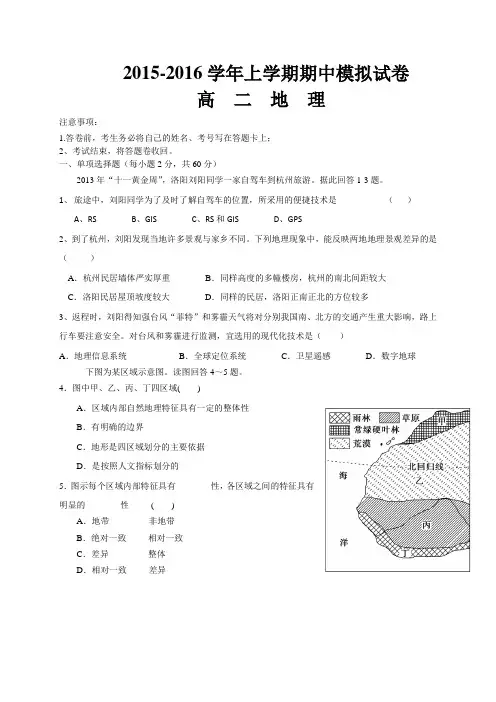
2015-2016学年上学期期中模拟试卷高二地理注意事项:1.答卷前,考生务必将自己的姓名、考号写在答题卡上;2、考试结束,将答题卷收回。
一、单项选择题(每小题2分,共60分)2013年“十一黄金周”,洛阳刘阳同学一家自驾车到杭州旅游。
据此回答1-3题。
1、旅途中,刘阳同学为了及时了解自驾车的位置,所采用的便捷技术是()A、RSB、GISC、RS和GISD、GPS2、到了杭州,刘阳发现当地许多景观与家乡不同。
下列地理现象中,能反映两地地理景观差异的是()A.杭州民居墙体严实厚重B.同样高度的多幢楼房,杭州的南北间距较大C.洛阳民居屋顶坡度较大D.同样的民居,洛阳正南正北的方位较多3、返程时,刘阳得知强台风“菲特”和雾霾天气将对分别我国南、北方的交通产生重大影响,路上行车要注意安全。
对台风和雾霾进行监测,宜选用的现代化技术是()A.地理信息系统B.全球定位系统C.卫星遥感D.数字地球下图为某区域示意图。
读图回答4~5题。
4.图中甲、乙、丙、丁四区域()A.区域内部自然地理特征具有一定的整体性B.有明确的边界C.地形是四区域划分的主要依据D.是按照人文指标划分的5.图示每个区域内部特征具有________性,各区域之间的特征具有明显的________性()A.地带非地带B.绝对一致相对一致C.差异整体D.相对一致差异高二地理答案1-5 DDCAD 6-10 DCAAB 11-15 CCADB 16—20 CDABB21-25 ABBAD 26-30 BABDC31、(1)自然原因:全球气候变暖,祁连山冰川萎缩,冰雪融水量减少,河流补给量减少;蒸发量增加,河流流量减小。
人为原因:人口增长过快,工农业生产发展,用水量不断增加。
(4分)(2)①该地区气候干旱,垦荒和过度放牧导致土地沙漠化(荒漠化、土地退化);②不合理的引水灌溉导致土壤盐碱化。
(2分)(3)①节约用水,合理用水;②培育和推广耐旱作物;③调整产业结构;④科学规划农、林、牧用地,退耕还林、还牧;⑤防止过度垦殖、过度放牧;⑥控制人口增长等。
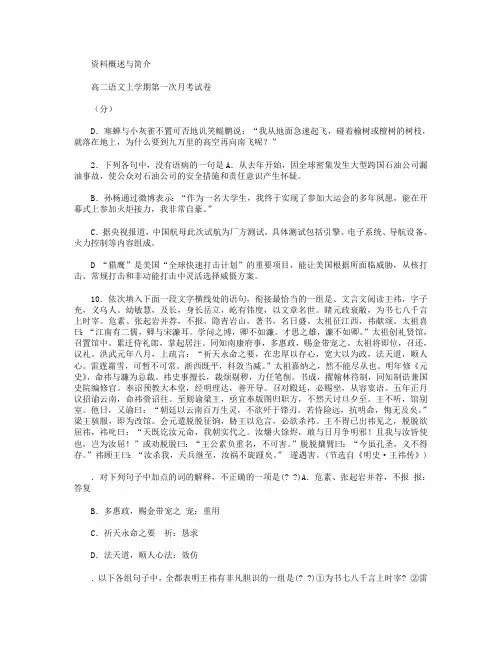
资料概述与简介 高二语文上学期第一次月考试卷 (分) D.寒蝉与小灰雀不置可否地讥笑鲲鹏说:“我从地面急速起飞,碰着榆树或檀树的树枝,就落在地上,为什么要到九万里的高空再向南飞呢?” 2.下列各句中,没有语病的一句是A.从去年开始,因全球密集发生大型跨国石油公司漏油事故,使公众对石油公司的安全措施和责任意识产生怀疑。
B.孙杨通过微博表示:“作为一名大学生,我终于实现了参加大运会的多年夙愿,能在开幕式上参加火炬接力,我非常自豪。
” C.据央视报道,中国航母此次试航为厂方测试,具体测试包括引擎、电子系统、导航设备、火力控制等内容组成。
D “猎鹰”是美国“全球快速打击计划”的重要项目,能让美国根据所面临威胁,从核打击、常规打击和非动能打击中灵活选择威慑方案。
10.依次填入下面一段文字横线处的语句,衔接最恰当的一组是、文言文阅读王祎,字子充,义乌人。
幼敏慧,及长,身长岳立,屹有伟度,以文章名世。
睹元政衰敝,为书七八千言上时宰。
危素、张起岩并荐,不报。
隐青岩山,著书,名日盛。
太祖征江西,祎献颂。
太祖喜曰:“江南有二儒,卿与宋濂耳。
学问之博,卿不如濂。
才思之雄,濂不如卿。
”太祖创礼贤馆,召置馆中。
累迁侍礼郎,掌起居注。
同知南康府事,多惠政,赐金带宠之。
太祖将即位,召还,议礼。
洪武元年八月,上疏言:“祈天永命之要,在忠厚以存心,宽大以为政,法天道,顺人心。
雷霆霜雪,可暂不可常。
浙西既平,科敛当减。
”太祖嘉纳之,然不能尽从也。
明年修《元史》,命祎与濂为总裁。
祎史事擅长,裁烦剔秽,力任笔削。
书成,擢翰林待制,同知制诰兼国史院编修官。
奉诏预教大本堂,经明理达,善开导。
召对殿廷,必赐坐,从容宴语。
五年正月议招谕云南,命祎赍诏往。
至则谕梁王,亟宜奉版图归职方,不然天讨旦夕至。
王不听,馆别室。
他日,又谕曰:“朝廷以云南百万生灵,不欲歼于锋刃。
若恃险远,抗明命,悔无及矣。
”梁王骇服,即为改馆。
会元遣脱脱征饷,胁王以危言,必欲杀祎。
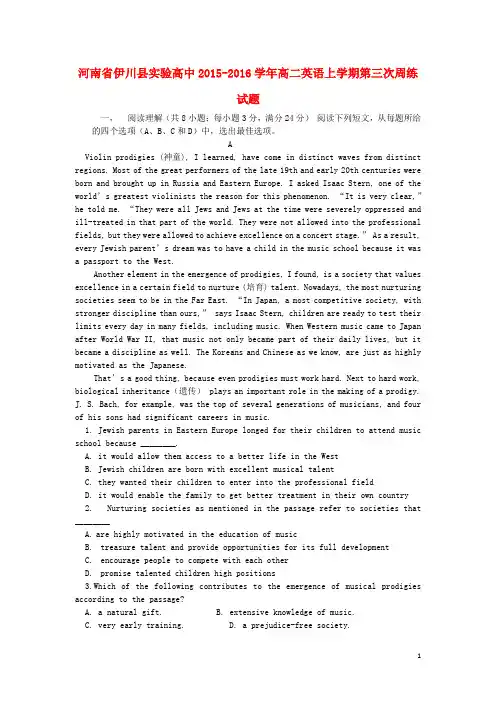
河南省伊川县实验高中2015-2016学年高二英语上学期第三次周练试题一,阅读理解(共8小题;每小题3分,满分24分)阅读下列短文,从每题所给的四个选项(A、B、C和D)中,选出最佳选项。
AViolin prodigies (神童), I learned, have come in distinct waves from distinct regions. Most of the great performers of the late 19th and early 20th centuries were born and brought up in Russia and Eastern Europe. I asked Isaac Stern, one of the world’s greatest violinists the reason for this phenomenon. “It is very clear,”he told me. “They were all Jews and Jews at the time were severely oppressed and ill-treated in that part of the world. They were not allowed into the professional fields, but they were allowed to achieve excellence on a concert stage.” As a result, every Jewish parent’s dream was to have a child in the music school because it was a passport to the West.Another element in the emergence of prodigies, I found, is a society that values excellence in a certain field to nurture (培育) talent. Nowadays, the most nurturing societies seem to be in the Far East. “In Japan, a most competitive society, with stronger discipline than ours,” says Isaac Stern, children are ready to test their limits every day in many fields, including music. When Western music came to Japan after World War II, that music not only became part of their daily lives, but it became a discipline as well. The Koreans and Chinese as we know, are just as highly motivated as the Japanese.That’s a good thing, because even prodigies must work hard. Next to hard work, biological inheritance(遗传) plays an important role in the making of a prodigy. J. S. Bach, for example, was the top of several generations of musicians, and four of his sons had significant careers in music.1. Jewish parents in Eastern Europe longed for their children to attend music school because ________.A. it would allow them access to a better life in the WestB. Jewish children are born with excellent musical talentC. they wanted their children to enter into the professional fieldD. it would enable the family to get better treatment in their own country2. Nurturing societies as mentioned in the passage refer to societies that ________A.are highly motivated in the education of musicB. treasure talent and provide opportunities for its full developmentC. encourage people to compete with each otherD. promise talented children high positions3.Which of the following contributes to the emergence of musical prodigies according to the passage?A. a natural gift.B. extensive knowledge of music.C. very early training.D. a prejudice-free society.4. Which of the following titles best summarizes the main idea of the passage?A.Jewish Contribution to MusicB. Training of Musicians in the WorldB.C. Music and Society D. The Making of Music ProdigiesBI promised Michael I wouldn’t mention this until the season was over.Now l think it's time.Early last season, I wrote a column about an art of kindness I had seen Jordan do to a disabled child outside the stadium.After it ran,I got a call from a man in the western suburbs.He said,“I read what you wrote about Jordan.but I thought I should tell you another thing I saw.”Here it comes, I thought. It always does. Write something nice about a person, and people call you up to say that the person is not so nice.A few weeks later Jordan and I were talking about something else before a game, and I brought up what the man had said. Was the man right? Had Jordan really been talking to those two boys in that poor and dirty neighborhood?"Not two boys," Jordan said. "But four."And he named them. He said four names. And what did they talk about? "Everything,” Jordan said. " Anything. I’ve asked to see their grades so that I can check to see if they're paying attention to their study. If it turns out that one or two of them may need teaching, I make sure they get it."It's just one more part of Michael Jordan's life,one more thing that no one knows about, and one more thing Jordan does fight for. The NBA season is over now, and those boys have their memories. So do J! When the expert reviewers begin to turn against Jordan as they surely will, I'll think about those boys under the streetlight, waiting for the man they know to come. For someone they can depend on.5. The writer wrote this story about Jordan and his young friends because _______A. he thought highly of Jordan's deedsB. he hated to see Jordan do something badC. he believed it was time to help the disabledD. he felt sure he needn't keep the promise then6. A man in the western suburbs made a call to_______A.know why Jordan stopped in a bad areaB. get a chance to become famous himselfC. let the writer know Jordan was not that niceD. offer an example to show how Jordan helped others7. Jordan talked with the boys because he _______.A.needed their supportB. had promised to do soC. liked to teach them to play basketballD. wanted to make sure they all studied well8. The text implies that Jordan is _______.A. an excellent basketball playerB. good at dealing with problems of lifeC. always ready to make friends with young peopleD. willing to do whateverhe can for the good of society完形填空(每小题3分,共60分)Six continuous days of spring rain had created a fierce and rapid river running by Nancy Brown's farm. As she tried to drive her 21 to higher ground to escape the disastrous flood, she 22 and hit her head on a 23 tree trunk. The fall knocked her 24 for a moment or two. When she came to, Lizzie, one of her oldest and 25 cows, was licking her 26 . The water was constantly 27 . Nancy got up and began walking 28 with Lizzie. The water was now waist high. Nancy's 29 got slower and slower. Finally, all she could do was to throw her arms 30 Lizzie’s neck and try to 31 . About 20 minutes later, Lizzie managed to 32 herself and Nancy out of the rough water and onto a bit of high land, a small island now in the middle of acres of 33 water. However, even though it was about noon, the sky was so _34_ and the rain and lightning so bad that it took 35 another two hours to discover Nancy and her cows. A(n) 36 lowered a paramedic (医务辅助人员) , who 37 Nancy to a life-support hoist (吊架). They raised her into the helicopter and took her to the school gym, where the Red Cross had 38 an emergency shelter. When the flood died down several days later, Nancy immediately 39 the island. Lizzie was 40 . She was one of the 19 cows that Nancy lost. "I owe my life to her," said Nancy sobbingly, knowing Lizzie, which rescued her, left helplessly, leaving her a new hope to live on, for which even thanks or miss seemed "unnecessary".21. A. sheep B. cows C. horses D. cattle22. A. shouted B. stood C. stopped D. slipped23. A. fallen B. grown C. hidden D. spread24. A. out B. in C. away D. down25. A. last B. first C. favorite D. best26. A. body B. head C. face D. mouth27. A. increasing B. flowing C. running D. rising28. A. easily B. slowly C. hardly D. hurriedly29. A. move B. breath C. pace D. action30. A. above B. around C. over D. into31. A. hang on B. hold back C. stretch out D. take off32. A. pull B. push C. carry D. force33. A. clean B. blue C. white D. green34. A. bright B. dark C. clear D. rainy35. A. rescuers B. villagers C. soldiers D. policemen36. A. lifeboat B. helicopter C. plane D. ambulance37. A. sent B. attached C. connected D. dragged38. A. worked out B. got into C. put down D. set up39. A. ran out of B. went away from C. went back to D. reached out for40. A. gone B. existed C. disappeared D. Approached三,改错题(文中共有10处错误,每处错误改对一处得2分,共20分)April 23rd is World Reading Day, this reminds us of the importance of reading. We are supposed to read more in that special day. But the situation for we to read nowadays is not satisfying. For example, when we are at home, we would rather to watch TV or go on the Internet than read books. As a result, we spend such little time on books. However, reading books have many advantages. Not only can our abilities and skills be improving, but also we can get some information from reading. Beside, reading can bring us happiness. I think it good habit that in our spare times we read more books of great use..参考答案1-4 ABAD 5~8 ACDD21-25 BDAAC 26-30 CDBCB 31-35 AACBA 36-40 BBDCA改错:1. this-which 2. In-on 3. We-us 4. to 去掉 5. Such-so6. have-has7. Improving-improved8. Beside-besides9. it 后加 a 10. Times-time。
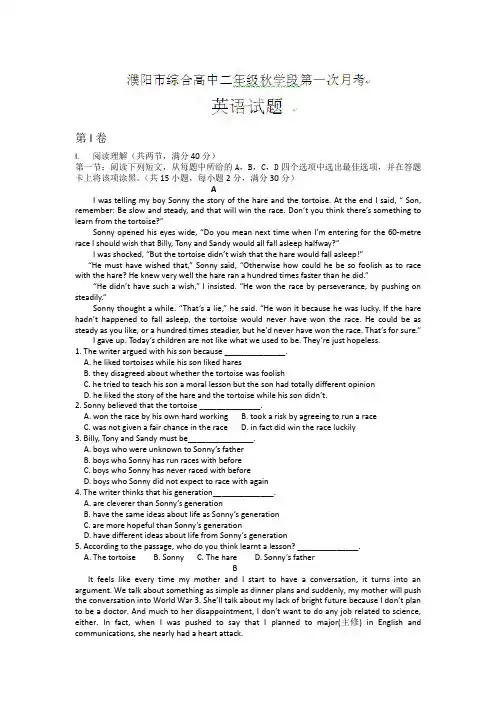
第I卷I.阅读理解(共两节,满分40分)第一节:阅读下列短文,从每题中所给的A,B,C,D四个选项中选出最佳选项,并在答题卡上将该项涂黑。
(共15小题,每小题2分,满分30分)AI was telling my boy Sonny the story of the hare and the tortoise. At the end I said, “ Son, remember: Be slow and steady, and that will win the race. Don’t you think there’s something to learn from the tortoise?”Sonny opened his eyes wide, “Do you mean next time when I’m entering for the 60-metre race I should wish that Billy, Tony and Sandy would all fall asleep halfway?”I was shocked, “But the tortoise didn’t wish that the hare would fall asleep!”“He must have wished that,” Sonny said, “Otherwise how could he be so foolish as to race with the hare? He knew very well the hare ran a hundred times faster than he did.”“He didn’t have such a wish,” I insisted. “He won the race by perseverance, by pushing on steadily.”Sonny thought a while. “That’s a lie,” he said. “He won it because he was lucky. If the hare hadn’t happened to fall asleep, the tortoise would never have won the race. He could be as steady as you like, or a hundred times steadier, but he’d never have won the race. That’s for sure.”I gave up. Today’s children are not like what we used to be. They’re just hopeless.1. The writer argued with his son because ______________.A. he liked tortoises while his son liked haresB. they disagreed about whether the tortoise was foolishC. he tried to teach his son a moral lesson but the son had totally different opinionD. he liked the story of the hare and the tortoise while his son didn’t.2. Sonny believed that the tortoise ______________.A. won the race by his own hard workingB. took a risk by agreeing to run a raceC. was not given a fair chance in the raceD. in fact did win the race luckily3. Billy, Tony and Sandy must be_______________.A. boys who were unknown to Sonny’s fatherB. boys who Sonny has run races with beforeC. boys who Sonny has never raced with beforeD. boys who Sonny did not expect to race with again4. The writer thinks that his generation______________.A. are cleverer than Sonny’s generationB. have the same ideas about life as Sonny’s generationC. are more hopeful than Sonny’s generationD. have different ideas about life from Sonny’s generation5. According to the passage, who do you think learnt a lesson? ______________.A. The tortoiseB. SonnyC. The hareD. Sonny’s fatherBIt feels like every time my mother and I start to have a conversation, it turns into an argument. We talk about something as simple as dinner plans and suddenly, my mother will push the conversation into World War 3. She’ll talk about my lack of bright future because I don’t plan to be a doctor. And much to her disappointment, I don’t want to do any job related to science, either. In fact, when I was pushed to say that I planned to major(主修) in English and communications, she nearly had a heart attack.“Why can’t you be like my co-worker’s son?” she bemoans all the time. Her coworker’s son received a four-year scholarship and is now earning 70,000 dollars a year as an engi neer. I don’t know what to answer except that I simply can’t be like Mr. Perfect as I’ve called the unnamed co-worker’s son. I can’t be like him. I am the type of the person who loved to help out in the community, write until the sun goes down, and most of all, wants to achieve a career because I love it, not because of a fame or salary.I understand why my mother is worried about my future major. I've seen my mother struggle to raise me on her small salary and work long hours. She leaves the house around 6:30 am and usually comes home around 5 pm or even 6 pm. However, I want her to know that by becoming a doctor, it doesn't mean I'll be successful. I'd rather follow my dreams and create my own future,6. Which of the following topics do the writer and his mother often talk about?A. the writer’s studiesB. wars around the worldC. dinner plansD. the writer’s future job7. We can infer from Paragraph 1 that the writer’s mother _____.A. doesn’t think the writer should be a doctorB. doesn’t want the writer to major in EnglishC. gets along very well with the writerD. doesn’t think working in the scientific field is a good idea8. The underlined word “bemoans” in Paragraph 2 most probably means “________”.A. disagreesB. shoutsC. smilesD. complains9. Which of the following statements is probably TRUE about the writer?A. He wants to be like his mother’s co-worker’s son.B. He wants to find a job in his community in the future.C. He wants to do something he really likes in the future.D. He doesn’t think his mother’s co-worker’s son is perfect.10. We can know from the last paragraph that ____.A. the writer’s mother works very hard for the familyB. the writer doesn’t know what his future will be likeC. th e writer doesn’t think being a doctor is a good jobD. the writer sometimes thinks his mother’s advice is very goodCTravel is fun and exciting, but it’s not if you get sick. You may think,“Not me, I won’t get sick in my holiday.” But, for many people, t hat is what happens.Of course you don’t want to spend your holiday sick in bed. So what can you do to stay in good health? There are three things you should remember when you travel: relax, sleep, and eat well.A holiday must be a time for relaxing. But very often it is not. Think about what you do when you are a traveller. There are many places to visit: museums, shops, parks, churches. You may spend most days walking around these places. This can be very tiring. You may have a terrible headache afte r a few hours. If this is the way you feel, you should take a rest. Don’t ask your body to do too much. A tired body means a weak body. And a weak body gets sick easily. So sit down for a few hours in a nice place. In good weather, look for a quiet park bench(石凳). Or you can stop at a cafe. You can learn a lot by watching people while you rest.Sleep is also important. If you want to stay healthy, you need to get enough sleep. You may have trouble sleeping at night when you travel. There may be too many noises in your hotel or the bed may be uncomfortable. If this is true, don’t be afraid to change rooms or hotels. Or you may get enough sleep for another reason. You may want to stay out late at night. In many cities, the nightlife can be very exciting. Then you should plan to sleep for an hour during the day. The extra(额外) hour can make a big difference。
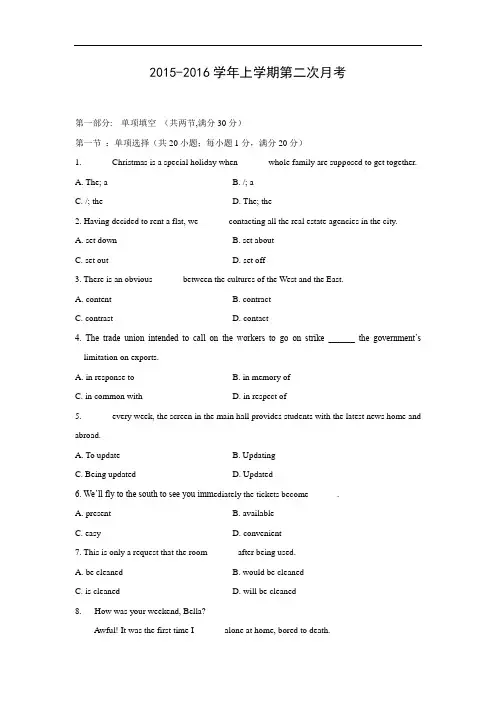
2015-2016学年上学期第二次月考第一部分: 单项填空(共两节,满分30分)第一节:单项选择(共20小题;每小题1分,满分20分)1. ______ Christmas is a special holiday when ______ whole family are supposed to get together.A. The; aB. /; aC. /; theD. The; the2. Having decided to rent a flat, we ______ contacting all the real estate agencies in the city.A. set downB. set aboutC. set outD. set off3. There is an obvious ______ between the cultures of the West and the East.A. contentB. contractC. contrastD. contact4. The trade union intended to call on the workers to go on strike ______ the government’s limitation on exports.A. in response toB. in memory ofC. in common withD. in respect of5. ______ every week, the screen in the main hall provides students with the latest news home and abroad.A. To updateB. UpdatingC. Being updatedD. Updated6. We’ll fly to the south to see you imm ediately the tickets become ______.A. presentB. availableC. easyD. convenient7. This is only a request that the room ______ after being used.A. be cleanedB. would be cleanedC. is cleanedD. will be cleaned8. --- How was your weekend, Bella?--- Awful! It was the first time I ______ alone at home, bored to death.A. has leftB. had leftC. has been leftD. had been left9. Changing schools didn’t make a difference _____ her life, and she adapted _____ the new school well.A. from; toB. to; toC. to; fromD. from; from10. The poor weather may have ______ the small number of visitors to the parade.A. resulted fromB. dated back toC. accounted forD. taken up11. The new buyer identified a dozen new sources for the material, ______ proved to be reliable.A. most of themB. most of whichC. most of whoD. most of those12. When you reach the other end of the bridge, I ______ right there to show you the way.A. am waitingB. have waitedC. was waitingD. will be waiting13. They say using cell phones can cause heart diseases, but I’m ______ about it.A. concernedB. scepticalC. enthusiasticD. particular14. ______ everyone else wouldn’t go to the dark cave, he went into it without hesitation.A. WhileB. In spite ofC. As long asD. Until15. The report based on figures from six different cities in Europe ______ six parts.A. make upB. consist ofC. is made up ofD. is consisted of16. The World Wide Web is sometimes jokingly called the World Wide Wait because it ______ be very slow.A. shouldB. mustC. willD. can17. The bus driver stopped just in time and ______ missed the old man lying in front.A. nearlyB. narrowlyC. hardlyD. mostly18. Her mother ______ her not to play computer games too much, but she showed no concern to it.A. persuadedB. suggestedC. warnedD. hoped19. Ben is always punctual, but he was late for school this morning. He ______ the first early bus.A. must missB. might missC. can have missedD. may have missed20. ---______ I’m afraid we’ll miss the plane.---We should have taken a taxi!A. Get a move on.B. I have had enough of you.C. Hang on a minute.D. That’s quite something.第二节:用所给词的适当形式填空或在空白处填上适当的词使句意完整通顺。
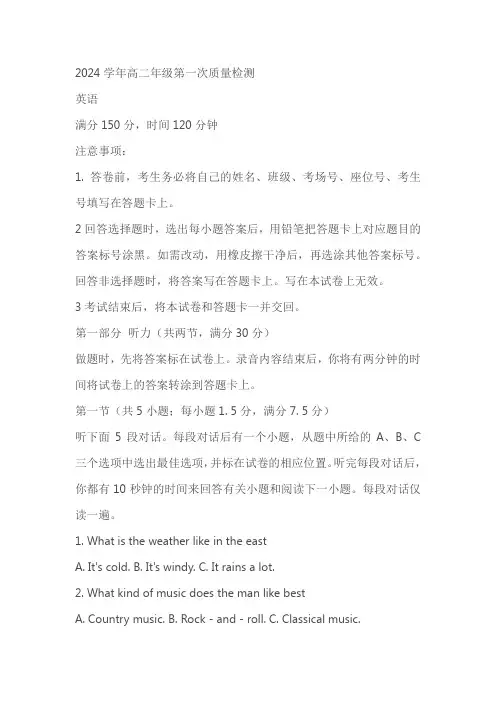
2024学年高二年级第一次质量检测英语满分150分,时间120分钟注意事项:1. 答卷前,考生务必将自己的姓名、班级、考场号、座位号、考生号填写在答题卡上。
2回答选择题时,选出每小题答案后,用铅笔把答题卡上对应题目的答案标号涂黑。
如需改动,用橡皮擦干净后,再选涂其他答案标号。
回答非选择题时,将答案写在答题卡上。
写在本试卷上无效。
3考试结束后,将本试卷和答题卡一并交回。
第一部分听力(共两节,满分30分)做题时,先将答案标在试卷上。
录音内容结束后,你将有两分钟的时间将试卷上的答案转涂到答题卡上。
第一节(共5小题;每小题1. 5分,满分7. 5分)听下面5段对话。
每段对话后有一个小题,从题中所给的A、B、C 三个选项中选出最佳选项,并标在试卷的相应位置。
听完每段对话后,你都有10秒钟的时间来回答有关小题和阅读下一小题。
每段对话仅读一遍。
1. What is the weather like in the eastA. It's cold.B. It's windy.C. It rains a lot.2. What kind of music does the man like bestA. Country music.B. Rock - and - roll.C. Classical music.3. What time is it nowA. 9: 00.B. 8: 30.C. 8: 40.4. Where was the man bornA. In China.B. In Canada.C. In America.5. What is the probable relationship between the speakersA. Classmates.B. Teacher and student.C. Manager and employee. 第二节(共15小题;每小题1. 5分,满分22. 5分)听下面5段对话或独白。
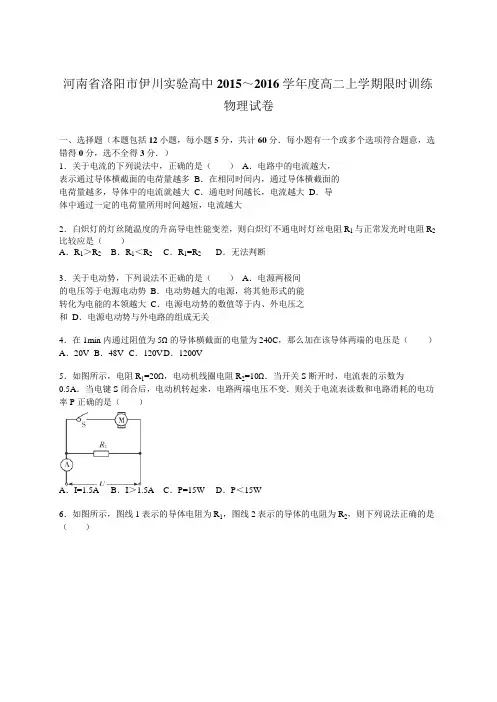
河南省洛阳市伊川实验高中2015~2016 学年度高二上学期限时训练物理试卷一、选择题(本题包括12 小题,每小题5 分,共计60 分.每小题有一个或多个选项符合题意,选错得0 分,选不全得3 分.)1.关于电流的下列说法中,正确的是()A.电路中的电流越大,表示通过导体横截面的电荷量越多B.在相同时间内,通过导体横截面的电荷量越多,导体中的电流就越大C.通电时间越长,电流越大D.导体中通过一定的电荷量所用时间越短,电流越大2.白炽灯的灯丝随温度的升高导电性能变差,则白炽灯不通电时灯丝电阻R1 与正常发光时电阻R2比较应是()A.R1>R2 B.R1<R2 C.R1=R2 D.无法判断3.关于电动势,下列说法不正确的是()A.电源两极间的电压等于电源电动势B.电动势越大的电源,将其他形式的能转化为电能的本领越大C.电源电动势的数值等于内、外电压之和D.电源电动势与外电路的组成无关4.在1min 内通过阻值为5Ω的导体横截面的电量为240C,那么加在该导体两端的电压是()A.20V B.48V C.120V D.1200V5.如图所示,电阻R1=20Ω,电动机线圈电阻R2=10Ω.当开关S 断开时,电流表的示数为0.5A.当电键S 闭合后,电动机转起来,电路两端电压不变.则关于电流表读数和电路消耗的电功率P 正确的是()A.I=1.5A B.I>1.5A C.P=15W D.P<15W6.如图所示,图线1 表示的导体电阻为R1,图线2 表示的导体的电阻为R2,则下列说法正确的是()A.R1:R2=1:3B.R1:R2=3:1C.将R1 与R2 串联后接于电源上,则电流比I1:I2=1:3D.将R1 与R2 并联后接于电源上,则电流比I1:I2=1:37.一太阳能电池板,测得它的开路电压为800mV,短路电流40mA.若将该电池板与一阻值为20Ω的电阻器连成一闭合电路,则它的路端电压是()A.0.10V B.0.20V C.0.30V D.0.40V8.直流电池组的电动势为E,内电阻为r,用它给电阻为R 的直流电动机供电,当电动机正常工作时,电动机两端的电压为U,通过电动机的电流是I,下列说法中正确的是()A.电动机输出的机械功率是UIB.电动机电枢上发热功率为I2RC.电源消耗的化学能功率为EID.电源的输出功率为EI﹣I2r9.如图电路中,在滑动变阻器的滑片P 向上端a 滑动过程中,两表的示数情况为()A.电压表示数增大,电流表示数减少B.电压表示数减少,电流表示数增大C.两电表示数都增大D.两电表示数都减少10.一个毫伏表,它的内阻是100Ω,量程是200mv,把它改变装成为量程为10A 的安培表,毫伏表上应()A.并联0.002Ω的电阻B.并联0.02Ω的电阻C.并联50Ω的电阻D.并联4900Ω的电阻11.在如图所示的电路中,电源电动势为E,内电阻为r,C 为电容器,R0 为定值电阻,R 为滑动变阻器.开关闭合后,灯泡L 能正常发光.当滑动变阻器的滑片向右移动时,下列判断正确的是()A.灯泡L 将变暗B.灯泡L 将变亮C.电容器C 的电荷量将减小D.电容器C 的电荷量将不变12.电源的电动势和内阻都保持一定,在外电路的电阻逐渐减小的过程中,下面说法中错误的是()A.电源的路端电压一定逐渐变小B.电源的输出功率一定逐渐变小C.电源内部消耗的功率一定逐渐变大D.电源的供电效率一定逐渐变小13.如图所示,直线OAC 为某直流电源的总功率P 随电流I 变化的图象,抛物线OBC 为该直流电源内部发热功率P 随电流I 变化的图线,若A、B 对应横坐标为2A,则下列说法中正确的是()A.电源电动势为3V,内阻为1ΩB.线段AB 表示功率的变化为2WC.电流为2A 时,外电路电阻为0.5ΩD.电流为3A 时,外电路电阻为2Ω二、非选择题(每题20 分,共40 分)14.如图所示电路中,电源电动势E=10V,内电阻r=0.5Ω,电动机的电阻R0=1.0Ω,电阻R1=1.5Ω,电动机正常工作时,电压表的示数U1=3.0V,求:(1)电源的总功率.电动机消耗的电功率,将电能转化为机械能的功率.(3)电源的输出功率.15.已知如图,E=6V,r=4Ω,R1=2Ω,R2 的变化范围是0﹣10Ω.求:①电源的最大输出功率;②R2 上消耗的最大功率.选做题16.如图所示,图线AB 是电路的路端电压随电流变化的关系图线.OM 是同一电源向固定电阻R 供电时,R 两端的电压电变化的图线,由图求:(1)在交点C 处表示电源的输出功率.电源的最大输出功率.17.如图所示电路中,电源电动势E=12V,内阻r=2Ω,R1=4Ω,R2=6Ω,R3=3Ω.(1)若在C、D 间连一个理想电压表,其读数是多少?若在C、D 间连一个理想电流表,其读数是多少?河南省洛阳市伊川实验高中2015~2016 学年度高二上学期限时训练物理试卷参考答案与试题解析一、选择题(本题包括12 小题,每小题5 分,共计60 分.每小题有一个或多个选项符合题意,选错得0 分,选不全得3 分.)1.关于电流的下列说法中,正确的是()A.电路中的电流越大,表示通过导体横截面的电荷量越多B.在相同时间内,通过导体横截面的电荷量越多,导体中的电流就越大C.通电时间越长,电流越大D.导体中通过一定的电荷量所用时间越短,电流越大【考点】电流、电压概念.【专题】恒定电流专题.【分析】物理学中用每秒通过导体横截面的电荷量来表示电流的强弱,叫做电流,定义式I=.【解答】解:A、电流大说明单位时间内流过导体横截面的电荷量多,但若不确定时间,则电荷量无法确定,故A 错误;B、由电流的定义可知,通过导体横截面的电荷量越多,导体中的电流一定越大;故B 正确;C、电流与通电时间长短无关;故C 错误;D、由电流定义可知,导体中通过一定的电荷量所用时间越短,电流越大;故D 正确;故选:BD.【点评】本题考查对电流定义的理解,要注意明确电流定义采用的是比值定义法,电流与电荷量及时间无关.2.白炽灯的灯丝随温度的升高导电性能变差,则白炽灯不通电时灯丝电阻R1 与正常发光时电阻R2比较应是()A.R1>R2 B.R1<R2 C.R1=R2 D.无法判断【考点】电阻率与温度的关系.【专题】恒定电流专题.【分析】各种材料的电阻率都会随温度的变化而变化.一般来说,金属的电阻率随温度升高而增大;电解液、半导体和绝缘体的电阻率则随温度升高而减小;而有些合金如锰铜合金和镍铜合金的电阻几乎不受温度变化的影响,常用来制作标准电阻.【解答】解:白炽灯灯丝由金属钨构成,金属的电阻率随温度的升高而升高,故电阻变大,即白炽灯的灯丝随温度的升高导电性能变差,故通电后温度升高,电阻变大,即R1<R2.故选B.【点评】本题关键要明确金属电阻率与温度的关系,然后根据电阻定律判断电阻的大小.3.关于电动势,下列说法不正确的是()A.电源两极间的电压等于电源电动势B.电动势越大的电源,将其他形式的能转化为电能的本领越大C.电源电动势的数值等于内、外电压之和D.电源电动势与外电路的组成无关【考点】电源的电动势和内阻.【专题】恒定电流专题.【分析】电源的电动势的物理意义是表示电源把其他形式的能转化为电能的本领大小,其大小等于电源没有接入电路时电源两极间的电压;电动势与外电路无关,由电源本身性质决定.【解答】解:A、电源两极间的电压为路端电压,一般是小于电源的电动势的;故A 不正确;B、电动势越大的电源,将其他形式的能转化为电能的本领越大;故B 正确;C、电动势在数值上等于内外电压之和;故C 正确;D、电动势是电源本身的性质,与外电路无关;故D 正确;本题选不正确的,故选:A.【点评】本题要正确理解电动势的物理意义,注意根据闭合电路欧姆定律进行分析内外电压之和.4.在1min 内通过阻值为5Ω的导体横截面的电量为240C,那么加在该导体两端的电压是()A.20V B.48V C.120V D.1200V【考点】欧姆定律.【专题】恒定电流专题.【分析】由电流的定义可求得电流,再由欧姆定律可求得导体两端的电压.【解答】解:由I=可知,导体中的电流I=A=4A;则导体两端的电压U=IR=45V=20V;故选:A.【点评】本题考查了欧姆定律和电流定义式的简单应用,是一道基础题目.5.如图所示,电阻R1=20Ω,电动机线圈电阻R2=10Ω.当开关S 断开时,电流表的示数为0.5A.当电键S 闭合后,电动机转起来,电路两端电压不变.则关于电流表读数和电路消耗的电功率P 正确的是()A.I=1.5A B.I>1.5A C.P=15W D.P<15W【考点】电功、电功率.【专题】恒定电流专题.【分析】当电键S 断开时,由欧姆定律求出电阻R1 的电压U;当电键S 闭合后,通过R1 的电流仍为0.5A,电动机的电路是非纯电阻电路,由I2<求出其电流的范围,即得到电流表电流的范围.由P=UI 求解电路中功率范围.【解答】解:当电键S 断开时,由欧姆定律得,U=I1R1=10V.当电键S 闭合后,通过R1 的电流仍为0.5A,电动机的电流I2<=A=1A,故电流表的电流I<1.5A,电动机中电功率P=UI<15W.故ABC 错误,D 正确.故选:D.【点评】本题要抓住非纯电阻电路与纯电阻电路的区别,电动机正常工作时,其电路是非纯电阻电路,欧姆定律不成立,I2<是关键不等式.6.如图所示,图线1 表示的导体电阻为R1,图线2 表示的导体的电阻为R2,则下列说法正确的是()A.R1:R2=1:3B.R1:R2=3:1C.将R1 与R2 串联后接于电源上,则电流比I1:I2=1:3D.将R1 与R2 并联后接于电源上,则电流比I1:I2=1:3【考点】闭合电路的欧姆定律;串联电路和并联电路.【专题】恒定电流专题.【分析】由题图象是电阻的伏安特性曲线,其斜率k 等于电阻的倒数.将R1 与R2 串联后接于电源上时,电流相等.将R1 与R2 并联后接于电源上时,电压相等,电流与电阻成反比.【解答】解:A、B 由图R1==1Ω,R2==3Ω,故A 正确.C、R1 与R2 串联后接于电源上,则电流比I1:I2=1:1.故C 错误.D、将R1 与R2 并联后接于电源上,电流比I1:I2=R2:R1=3:1 故D 错误.故选A【点评】本题考查识别、理解物理图象的能力.物理图象往往从数学角度,研究图象的斜率、面积、交点等意义.7.一太阳能电池板,测得它的开路电压为800mV,短路电流40mA.若将该电池板与一阻值为20Ω的电阻器连成一闭合电路,则它的路端电压是()A.0.10V B.0.20V C.0.30V D.0.40V【考点】闭合电路的欧姆定律.【专题】恒定电流专题.【分析】由电池板开路电路等于电源的电动势,求出电动势,由短路电流求出电源的内阻.再根据闭合电路欧姆定律求出电流和路端电压.【解答】解:电源没有接入外电路时,路端电压值等于电动势,则知电池板的电动势为:E=800mV由闭合电路欧姆定律得短路电流:I 短=则电源内阻:r===20Ω该电源与20Ω的电阻连成闭合电路时,电路中电流:I==mA=20mA 故路端电压:U=IR=20mA×20Ω=400mV=0.40V;故选:D.【点评】对于电动势的概念要理解:电动势等于外电压和内电压之和,当外电路开路时,内电压为零,开路电路等于电源的电动势.8.直流电池组的电动势为E,内电阻为r,用它给电阻为R 的直流电动机供电,当电动机正常工作时,电动机两端的电压为U,通过电动机的电流是I,下列说法中正确的是()A.电动机输出的机械功率是UIB.电动机电枢上发热功率为I2RC.电源消耗的化学能功率为EID.电源的输出功率为EI﹣I2r【考点】电功、电功率.【专题】恒定电流专题.【分析】当电动机正常工作时,其电路是非纯电阻电路,输入的功率是电功率,根据P=UI 求解.发热功率由P=I2r 求解.输出功率由能量守恒定律研究,电源消耗的化学能功率就是电源的总功率,则P=EI.【解答】解:A、电动机输入的功率是电功率,即P 电=UI,电动机的输出功率是机械功率,根据能量守恒定律得,P 出=P 电﹣P 热=UI﹣I2R.故A 错误,B 正确.C、电源消耗的化学能功率就是电源的总功率,则P=EI.故C 正确.D、电源的输出功率P′=P﹣P r=EI﹣I2r.故D 正确.故选:BCD【点评】本题中当电动机正常工作时其电路是非纯电阻电路,求电功率只能用P=UI,求热功率只能用P=I2r.而输出的机械功率只能根据能量守恒求解,而且电功率大于热功率.9.如图电路中,在滑动变阻器的滑片P 向上端a 滑动过程中,两表的示数情况为()A.电压表示数增大,电流表示数减少B.电压表示数减少,电流表示数增大C.两电表示数都增大D.两电表示数都减少【考点】闭合电路的欧姆定律.【专题】恒定电流专题.【分析】动态变化分析问题一般按照“局部→整体→局部”的顺序,分析总电阻变化→总电流变化→总 电压变化,再分析局部电压、电流、功率的变化进行.对于电流表读数来说,由于滑动变阻器的电 流、电压和电阻都在变化,不好确定,可从总电流的变化和 R 2 电流变化确定.【解答】解:当滑动变阻器的滑片 P 向 a 滑动时,接入电路的电阻增大,与 R 2 并联的电阻增大,外 电路总电阻 R 总增大,总电流 I 减小,路端电压 U=E ﹣Ir 增大,电压表读数增大;并联部分的电阻增 大,分担的电压增大,U 2 增大,流过 R 2 的电流 I 2 增大,电流表的读数 I A =I ﹣I 2,则减小.故 A 正 确,BCD 错误.故选:A .【点评】电路动态变化分析是常见的题型,容易犯的错误是认为支路电阻增大,并联总电阻减 小.本题中变阻器的电压、电流和电阻都是变化的,技巧是研究干路电流和另一支路电流变化情况 来确定10.一个毫伏表,它的内阻是 100Ω,量程是 200mv ,把它改变装成为量程为 10A 的安培表,毫伏表 上应( )A .并联 0.002Ω 的电阻B .并联 0.02Ω 的电阻C .并联 50Ω 的电阻D .并联 4900Ω 的电阻【考点】把电流表改装成电压表.【专题】实验题;恒定电流专题.【分析】该表是毫伏表,所以满偏电流将表头改装为电流表需要并入一个电阻 R ,所以加在 表头和电阻上的电压相等,即:I g R g =I R R ,改装后的电流表量程为 I ,I=I g +I R ,由以上三式式得:=.【解答】解:经分析知:I g R g =I R R …①I=I g +I R …②…③联立①②③解得:,代入数据得: 故选 B .【点评】熟练掌握电表改装原理是解决此类问题的关键.11.在如图所示的电路中,电源电动势为 E ,内电阻为 r ,C 为电容器,R 0 为定值电阻,R 为滑动变 阻器.开关闭合后,灯泡 L 能正常发光.当滑动变阻器的滑片向右移动时,下列判断正确的是 ( )A.灯泡L 将变暗B.灯泡L 将变亮C.电容器C 的电荷量将减小D.电容器C 的电荷量将不变【考点】闭合电路的欧姆定律.【专题】恒定电流专题.【分析】电路稳定时,与电容器串联的电路没有电流,相当于断路.当滑动变阻器的滑片向右移动时,变阻器在路电阻增大,外电阻增大,电路中电流减小,灯L 变暗.电容器的电压等于路端电压,分析其电压变化,由Q=CU 分析电量的变化.【解答】解:A、当滑动变阻器的滑片向右移动时,变阻器接入电路的电阻增大,外电阻增大,电路中电流减小,灯L 变暗,故A 正确,B 错误.C、电路中电流减小,则电源内阻所占电压减小,则路端电压增大,电容器的电压等于路端电压,可见其电压是增大的,则由Q=CU 知,电容器C 的电荷量将增大.故CD 错误.故选:A【点评】本题是电路的动态变化分析问题,可直接根据路端电压随外电阻增大而增大,判断电容器两端电压的变化.12.电源的电动势和内阻都保持一定,在外电路的电阻逐渐减小的过程中,下面说法中错误的是()A.电源的路端电压一定逐渐变小B.电源的输出功率一定逐渐变小C.电源内部消耗的功率一定逐渐变大D.电源的供电效率一定逐渐变小【考点】闭合电路的欧姆定律.【专题】恒定电流专题.【分析】外电路的电阻逐渐减小的过程中总电阻发生变化,根据电源的电动势和内阻不变,知总电流发生变化,内电压外电压也发生变化.从而根据功率公式推导各物理量间的变化情况.【解答】解:A、R 总减小,有闭合电路欧姆定律I=可知,电路中总电流减小,路端电压U=E ﹣rI 可知,U 减小,故A 正确;B、电路中的电流为I=,随着R 的减小,I 增大,电源的输出功率为P=I2R 可知,当R=r 时,输出功率最大,而本题中没有告诉二者之间的关系,故B 错误;C、电路中的电流为I=,随着R 的减小,I 增大,电源的内阻消耗的功率为P=I2r,消耗的功率增大,故C 正确;D、电源的供电效率为η=,随着I 的增大,η将减小,故D 正确;本题选错误的,故选B【点评】解决本题的关键抓住电源的电动势和内阻不变,根据闭合电路欧姆定律进行动态分析.13.如图所示,直线 OAC 为某直流电源的总功率 P 随电流 I 变化的图象,抛物线 OBC 为该直流电 源内部发热功率 P 随电流 I 变化的图线,若 A 、B 对应横坐标为 2A ,则下列说法中正确的是( )A .电源电动势为 3V ,内阻为 1ΩB .线段 AB 表示功率的变化为 2WC .电流为 2A 时,外电路电阻为 0.5ΩD .电流为 3A 时,外电路电阻为 2Ω【考点】闭合电路的欧姆定律;电功、电功率.【专题】恒定电流专题.【分析】由图读出 I=3A 时,电源的功率 P=9W ,电源内部发热功率 P 热=9W ,根据电源的功率 P=EI和电源内部发热功率 P 热=I 2r 分别求出电源的电动势和内阻.当电流 I=2A 时,分别求出电源的功率和电源内部发热功率,求出线段 AB 表示功率的变化.根据欧姆定律求出外电阻.【解答】解:A 、由图读出 I=3A 时,电源的功率 P=9W ,由 P=EI 得,E=3V .电源内部发热功率 P热=9W ,由 P 热=I 2r 求出 r=1Ω.故 A 正确.B 、当电流 I=2A 时,电源的功率 P=EI=6W ,电源内部发热功率 P 热=I 2r=4W ,则线段 AB 表示功率的变化为 2W .故 B 正确.C 、当电流 I=2A 时,由 P ﹣P 热=I 2R ,得 R=0.5Ω.故 C 正确.D 、当电流为 3A 时,由题 R=0.故 D 错误.故选 ABC 【点评】对于电源要分清三种功率及其关系:电源的总功率 P 总=EI ,电源内部发热功率 P 热=I 2r ,外电路消耗功率 P 外=UI=I 2R ,且根据能量关系得 P 总=P 外+P 热.二、非选择题(每题 20 分,共 40 分)14.如图所示电路中,电源电动势 E=10V ,内电阻 r=0.5Ω,电动机的电阻 R 0=1.0Ω,电阻 R 1=1.5Ω,电动机正常工作时,电压表的示数 U 1=3.0V ,求:(1)电源的总功率.电动机消耗的电功率,将电能转化为机械能的功率.(3)电源的输出功率.【考点】电功、电功率.【专题】恒定电流专题.【分析】(1)通过电阻两端的电压求出电路中的电流 I ,电源的总功率为 P=EI ,即可求得;由U 内=Ir 可求得电源内阻分得电压,电动机两端的电压为U=E﹣U1﹣U 内,电动机消耗的功率为P =UI;电动机将电能转化为机械能的功率为P 机=P 电﹣I2R0.电(3)由P 热=I2r 可求的电源内阻消耗的功率,电源的输出功率为P 出=P﹣P 热.【解答】解:(1)电路中的电流为I==A=2A;电源的总功率为P=EI=10×2W=20W;电源内阻分得电压为U 内=Ir=2×0.5V=1V,电动机两端的电压为U=E﹣U1﹣U 内=(10﹣3﹣1)V=6V,电动机消耗的电功率为P 电=UI=6×2W=12W;电动机将电能转化为机械能的功率为P 机=P 电﹣I2R0=12W﹣22×1W=8W.(3)电源内阻消耗的功率为P 内=I2r=22×0.5W=2W,电源的输出功率为P 出=P﹣P 热=20﹣2W=18W.答:(1)电源的总功率为20W.电动机消耗的电功率为12W,将电能转化为机械能的功率为8W.(3)电源的输出功率为18W.【点评】对于电动机电路,关键要正确区分是纯电阻电路还是非纯电阻电路:当电动机正常工作时,是非纯电阻电路;当电动机被卡住不转时,是纯电阻电路.对于电动机的输出功率,往往要根据能量守恒求解.15.已知如图,E=6V,r=4Ω,R1=2Ω,R2 的变化范围是0﹣10Ω.求:①电源的最大输出功率;②R2 上消耗的最大功率.【考点】闭合电路的欧姆定律;电功、电功率.【专题】恒定电流专题.【分析】(1)当外电阻等于内电阻时,电源的输出功率最大,结合功率公式求出电源的最大输出功率.将R1 等效到电源的内部,抓住外电阻等于内电阻时,电源的输出功率最大,求出R2 上消耗的最大功率.【解答】解:(1)当外电阻等于内电阻时,即R1+R2=r 时,电源的输出功率最大,最大输出功率P==.将R1 等效到电源的内部,则内阻r′=R1+r=2+4=6Ω,当R2=r′=6Ω时,R2 上消耗的功率最大,最大功率=1.5W.答:(1)电源的最大输出功率为2.25W;R2 上消耗的最大功率为1.5W.【点评】解决本题的关键知道当电源的内阻与外电阻相等时,电源的输出功率最大.难度不大.选做题16.如图所示,图线AB 是电路的路端电压随电流变化的关系图线.OM 是同一电源向固定电阻R 供电时,R 两端的电压电变化的图线,由图求:(1)在交点C 处表示电源的输出功率.电源的最大输出功率.【考点】闭合电路的欧姆定律.【专题】恒定电流专题.【分析】(1)根据图线AB 得出电源的电动势和内电阻,结合交点处的电压和电流求出电源的输出功率.当外电阻等于内电阻时,电源的输出功率最大,结合P=求出电源的最大输出功率.【解答】解:(1)交点处对应的电压U=4V,电流I=2A,则电源的输出功率P=UI=4×2W=8W.根据图线AB 知,电动势E=6V,内阻r=,当外电阻等于内阻时,电源的输出功率最大,最大输出功率P=.答:(1)在交点C 处表示电源的输出功率为8W.电源的最大输出功率为9W.【点评】对于图线关键要根据物理规律,从数学角度来理解其物理意义.本题要抓住图线的斜率、交点的意义来理解图象的意义.17.如图所示电路中,电源电动势E=12V,内阻r=2Ω,R1=4Ω,R2=6Ω,R3=3Ω.(1)若在C、D 间连一个理想电压表,其读数是多少?若在C、D 间连一个理想电流表,其读数是多少?【考点】闭合电路的欧姆定律.【专题】恒定电流专题.【分析】理想电表对电路没有影响,理想电压表内阻无穷大,相当于开路;理想电流表内阻为零,相当于短路.C、D 间接入理想电压表后,R3 可看做导线,R1 与R2 为串联关系,电压表示数为R2 电压.接入理想电流表时,R2 和R3 并联后再与R1 串联,电流表示数为R3 支路电流;根据欧姆定律和电路的连接关系求解.【解答】解:(1)若在C、D 间接入理想电压表,电路连接如图由闭合电路欧姆定律得干路电流I1==A=1A理想电压表读数为U V=I1R2=6V若在C、D 间连一个理想电流表,电路连接如图所示这时电阻R2 与R3 并联,并联电阻大小R23==2Ω 根据闭合电路欧姆定律,有I2==1.5A理想电流表读数为I A=I2=1A答:(1)若在C、D 间连一个理想电压表,其读数是6V.若在C、D 间连一个理想电流表,其读数是1A.【点评】理想电表的串并联规律为:理想电压表与电阻串联,电阻可看作导线;理想电流表与电阻并联,电阻被短路,相当于不存在.闭合电路的欧姆定律在使用时要从总电阻和干路电流入手,分步操作,层层推进,避免急于求成,造成解题失误.。
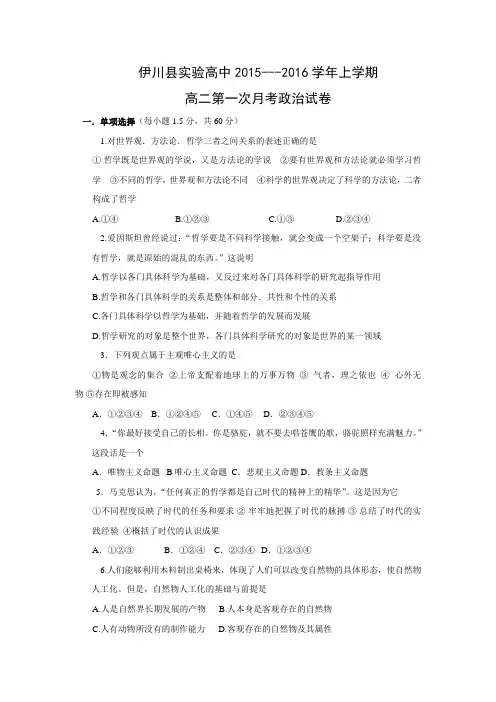
伊川县实验高中2015---2016学年上学期高二第一次月考政治试卷一.单项选择(每小题1.5分,共60分)1.对世界观.方法论.哲学三者之间关系的表述正确的是①哲学既是世界观的学说,又是方法论的学说②要有世界观和方法论就必须学习哲学③不同的哲学,世界观和方法论不同④科学的世界观决定了科学的方法论,二者构成了哲学A.①④B.①②③C.①③D.②③④2.爱因斯坦曾经说过:“哲学要是不同科学接触,就会变成一个空架子;科学要是没有哲学,就是原始的混乱的东西。
”这说明A.哲学以各门具体科学为基础,又反过来对各门具体科学的研究起指导作用B.哲学和各门具体科学的关系是整体和部分.共性和个性的关系C.各门具体科学以哲学为基础,并随着哲学的发展而发展D.哲学研究的对象是整个世界,各门具体科学研究的对象是世界的某一领域3.下列观点属于主观唯心主义的是①物是观念的集合②上帝支配着地球上的万事万物③气者,理之依也④心外无物⑤存在即被感知A.①②③④ B.①②④⑤ C.①④⑤ D.②③④⑤4.“你最好接受自己的长相。
你是骆驼,就不要去唱苍鹰的歌,骆驼照样充满魅力。
”这段话是一个A.唯物主义命题 B唯心主义命题 C.悲观主义命题 D.教条主义命题5.马克思认为,“任何真正的哲学都是自己时代的精神上的精华”。
这是因为它①不同程度反映了时代的任务和要求②牢牢地把握了时代的脉搏③总结了时代的实践经验④概括了时代的认识成果A.①②③ B.①②④ C.②③④ D.①②③④6.人们能够利用木料制出桌椅来,体现了人们可以改变自然物的具体形态,使自然物人工化。
但是,自然物人工化的基础与前提是A.人是自然界长期发展的产物B.人本身是客观存在的自然物C.人有动物所没有的制作能力D.客观存在的自然物及其属性7.人类社会发展的实践证明,没有社会性的劳动,就没有人的出现,也就没有人的意识的产生。
这表明A.意识是人脑的机能 B.意识是自然界和社会发展的产物C.意识是自然界的产物 D.意识是社会的产物8.随着现代科学技术的发展,人们可以通过实践活动来改变自然界。
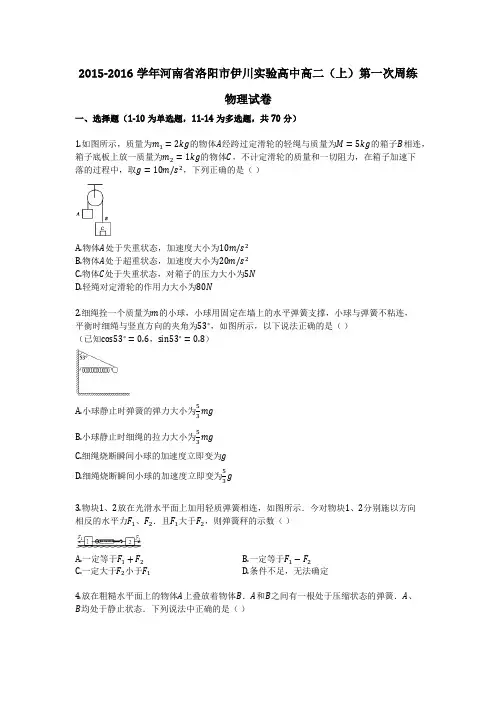
2015-2016学年河南省洛阳市伊川实验高中高二(上)第一次周练物理试卷一、选择题(1-10为单选题,11-14为多选题,共70分)1.如图所示,质量为的物体经跨过定滑轮的轻绳与质量为的箱子相连,箱子底板上放一质量为的物体,不计定滑轮的质量和一切阻力,在箱子加速下落的过程中,取,下列正确的是()A.物体处于失重状态,加速度大小为B.物体处于超重状态,加速度大小为C.物体处于失重状态,对箱子的压力大小为D.轻绳对定滑轮的作用力大小为2.细绳拴一个质量为的小球,小球用固定在墙上的水平弹簧支撑,小球与弹簧不粘连,平衡时细绳与竖直方向的夹角为,如图所示,以下说法正确的是()(已知,)A.小球静止时弹簧的弹力大小为B.小球静止时细绳的拉力大小为C.细绳烧断瞬间小球的加速度立即变为D.细绳烧断瞬间小球的加速度立即变为3.物块、放在光滑水平面上加用轻质弹簧相连,如图所示.今对物块、分别施以方向相反的水平力、.且大于,则弹簧秤的示数()A.一定等于B.一定等于C.一定大于小于D.条件不足,无法确定4.放在粗糙水平面上的物体上叠放着物体.和之间有一根处于压缩状态的弹簧.、均处于静止状态.下列说法中正确的是()A.受到向左的摩擦力B.对的摩擦力向右C.地面对的摩擦力向右D.地面对没有摩擦力5.如图所示,质量为的球置于斜面上,被一个竖直挡板挡住、现用一个力拉斜面,使斜面在水平面上做加速度为的匀加速直线运动,忽略一切摩擦,以下说法中正确的是()A.若加速度足够小,竖直挡板对球的弹力可能为零B.若加速度足够大,斜面对球的弹力可能为零C.斜面和挡板对球的弹力的合力等于D.斜面对球的弹力不仅有,而且是一个定值6.如图所示,带支架的平板小车沿水平面向左做直线运动,小球用细线悬挂于支架前端,质量为的物块始终相对于小车静止地摆放在右端.与小车平板间的动摩擦因数为.若某时刻观察到细线偏离竖直方向角,则此刻小车对物块产生的作用力的大小和方向为()A.,斜向右上方B.,斜向左上方C.,水平向右D.,竖直向上7.一个静止的质点,在时间内受到合力的作用,合力的方向始终在同一直线上,合力随时间的变化图线如图所示.则质点在()A.第末速度方向改变B.第末加速度为零C.第末运动速度为零D.第末回到原出发点8.受水平向右外力作用的物体如图,在粗糙水平面上向右做直线运动,其图线如图所示,则()A.在秒内,外力大小不断减小B.在时刻,外力为零C.在秒内,外力大小不断减小D.在秒内,外力大小可能先增大后减小9.如图所示,在光滑水平面上有甲、乙两木块,质量分别为和,中间用一原长为、劲度系数为的轻质弹簧连接起来,现用一水平力向左推木块乙,当两木块一起匀加速运动时,两木块之间的距离是()A. B.C. D.10.如图物体叠放在物体上,置于光滑水平面上.,质量分别为,,,之间的动摩擦因数,开始时,此后逐渐增加,在增大到的过程中,则()A.当拉力时,两物体均保持静止状态B.两物体开始没有相对运动,当拉力超过时,开始相对滑动C.两物体间从受力开始就有相对运动D.两物体间始终没有相对运动11.三百多年前,伽利略用实验和推理,推翻了已在欧洲流行了近两千年的亚里士多德关于力和运动的理论,开启了物理学发展的新纪元.以下说法与事实相符的是()A.根据亚里士多德的论断,力是改变物体运动状态的原因B.笛卡尔经研究指出:如果运动中的物体没有受到力的作用,它将继续以同一速度沿同一直线运动,既不停下来也不偏离原来的方向C.伽利略通过数学推算并用实验验证了小球在斜面上从静止开始运动的位移与所用时间的平方成正比D.牛顿总结伽利略等前人的经验,得出了牛顿第一定律12.如图所示,一木块在光滑水平面上受一恒力作用,前方固定一足够长的弹簧,则当木块接触弹簧后()A.木块立即做减速运动B.木块在一段时间内速度仍可增大C.当等于弹簧弹力时,木块速度最大D.弹簧压缩量最大时,木块加速度为零13.如图甲所示,、两物体叠放在一起,放在光滑的水平面上,从静止开始受到一变力的作用,该力与时间的关系如图乙所示,、始终相对静止,则下列说法不正确的是()A.时刻,、间静摩擦力最大B.时刻,速度最大C.时刻,、间静摩擦力为零D.时刻,、位移最大14.如图所示,质量为的物体用细绳拴住放在水平粗糙传送带上,物体距传送带左端距离为,稳定时绳与水平方向的夹角为,当传送带分别以、的速度做逆时针转动时,绳中的拉力分别为、;若剪断细绳时,物体到达左端的时间分别为、,则下列说法正确的是()A. B.C.大于D.可能等于二、计算题(共30分)15.质量为的弹性球从空中某高度由静止开始下落,该下落过程对应的图象如图所示.球与水平地面相碰后离开地面时的速度大小为碰撞前的.设球受到的空气阻力大小恒为,取,则:弹性球受到的空气阻力的大小为________,弹性球第一次碰撞后反弹的高度为________.16.如图所示,在光滑的水平地面上有一个长为,质量为的木板,在木板的左端有一个质量为的小物体,、之间的动摩擦因数为,当对施加水平向右的力作用时(设、间的最大静摩擦力大小与滑动摩擦力大小相等),若,则、加速度分别为多大?若,则、加速度分别为多大?在的条件下,若力作用时间,刚好到达木板的右端,则木板长应为多少?答案1. 【答案】C【解析】先分别对和整体受力分析,求解出加速度;然后再隔离,受力分析后根据牛顿第二定律列式求解.【解答】解:、、设加速度大小为,对物体,受到重力和拉力,根据牛顿第二定律,有:;对物体整体,根据牛顿第二定律,有:;联立解得:物体以的加速度加速上升,超重,故错误,错误;、物体受重力和支持力,根据牛顿第二定律,有:,解得,故正确;、滑轮受力平衡,故;故轻绳对定滑轮的作用力为,故错误;故选.2. 【答案】B,D【解析】小球静止时,分析受力情况,由平衡条件求解弹簧的弹力大小和细绳的拉力大小.细绳烧断瞬间弹簧的弹力不变,则小球所受的合力与烧断前细绳拉力的大小相等、方向相反,即可求出加速度.【解答】解:、小球静止时,分析受力情况,如图,由平衡条件得:弹簧的弹力大小为:细绳的拉力大小为:.故错误,正确.、细绳烧断瞬间弹簧的弹力不变,则小球所受的合力与烧断前细绳拉力的大小相等、方向相反,则此瞬间小球的加速度大小为:.故错误,正确.故选:3. 【答案】C【解析】先用整体法求出加速度,然后用隔离法隔离出物体,运用牛顿第二定律求出弹簧的拉力.【解答】解:两个物体一起向左做匀加速直线运动,对两个物体整体运用牛顿第二定律,有①再对物体受力分析,运用牛顿第二定律,得到②由①②两式解得由于大于,故一定大于小于故选.4. 【答案】D【解析】压缩状态的弹簧对有向左的弹力,有向左运动的趋势,受到向右的摩擦力,根据牛顿第三定律可知,对的摩擦力向左.对整体研究,地面对没有摩擦力.【解答】解:、压缩状态的弹簧对有向左的弹力,有向左运动的趋势,受到向右的摩擦力.故错误.、由上可知:对的摩擦力向右,根据牛顿第三定律可知,对的摩擦力向左.故错误.、对整体研究,根据平衡条件分析可知,地面对没有摩擦力.故错误,正确.故选5. 【答案】D【解析】分析小球受到的重、斜面的支持力、竖直挡板的水平弹力,然后向水平和竖直分解斜面的支持力,在竖直方向列力的平衡方程,在水平方向列牛顿第二定律方程,根据所列的方程分析即可选出答案.【解答】解:小球受到的重、斜面的支持力、竖直挡板的水平弹力,设斜面的倾斜角为则竖直方向有:∵ 和不变,∴无论加速度如何变化,不变且不可能为零,故错,对.水平方向有:∵ ,若加速度足够小,竖直挡板的水平弹力不可能为零,故错.斜面和挡板对球的弹力的合力即为竖直方向的与水平方向的力的合成,因此大于,故错误.故选.6. 【答案】A【解析】先以为研究对象,根据牛顿第二定律求出加速度.再对研究,由牛顿第二定律求解小车对物块产生的摩擦力大小和方向,再对支持力进行合成,得到小车对的作用力的大小和方向.【解答】解:以为研究对象,分析受力如图,根据牛顿第二定律得:得:,方向水平向右.再对研究得:小车对的摩擦力,方向水平向右,小车对的支持力大小为,方向竖直向上,则小车对物块产生的作用力的大小为:,方向斜向右上方故选:7. 【答案】C【解析】解决本题的关键根据图象作出图,即可得出时,时物体的速度相等.时,时,时物体的速度相同.即物体在内加速,在内减速,如此反复.但整个过程当中物体运动的方向不变.【解答】解:根据题意可知合力随时间周期性变化,故根据牛顿第二定律可得:物体的加速度.故在内物体做加速度为匀加速直线运动,在内物体做加速度为的匀减速直线运动,作出图象如图.、由图象可以看出物体一直向同一方向运动,速度方向始终没有发生改变,故错误;、末合力不为零,故加速度不为零,故错误;、由图象可以看出末速度为零,故正确;、由于整个运动过程中,质点一直向一个方向运动,不可能回到原出发点.故错误.故选:.8. 【答案】A,C【解析】速度时间图线的切线斜率表示瞬时加速度大小,根据加速度的变化,结合牛顿第二定律得出外力的变化.【解答】解:、在时间内,物体做变加速运动,图线的斜率减小,则加速度减小,根据牛顿第二定律得,因为阻力的大小不变,知外力减小.故正确;、在时刻,图线的切线斜率为零,加速度为零,则外力等于阻力.故错误.、在时间内,物体做减速运动,切线的斜率逐渐增大,则加速度增大,根据牛顿第二定律得,若外力的方向与速度方向相同,则外力不断减小.由于的大小减小为零后,可能反向增大,加速度增大.故正确,错误.故选:.9. 【答案】B【解析】原长为,由胡克定律求出弹簧被压缩的长度,甲乙间的距离就知道了.【解答】解:两木块一起匀加速运动,它们有共同的加速度,对于整体,由 ①对于甲,弹②对弹簧弹③由①②③解得,,故两木块之间的距离是,所以正确.故选:.10. 【答案】D【解析】隔离对分析,求出发生相对滑动时的临界加速度,再对整体分析,运用牛顿第二定律求出刚好发生相对滑动时的拉力.【解答】解:隔离对分析,当间摩擦力达到最大静摩擦力时,、发生相对滑动,则.再对整体分析.知当拉力达到时,、才发生相对滑动.在小于时,两者是保持相对静止的,相对于地面是运动的.故正确,、、错误.故选.11. 【答案】B,C,D【解析】根据物理学史和常识解答,记住著名物理学家的主要贡献即可.【解答】解:、亚里士多德的论断,力是维持物体运动的原因.伽利略根据理想斜面实验,发现了力不是维持物体运动的原因,故错误;、笛卡尔指出:如果运动中的物体没有受到力的作用,不停下来也不偏离原来的方向,故正确;、伽利略通过数学推算并用实验验证了小球在斜面上从静止开始运动的位移与所用时间的平方成正比.故正确.、牛顿根据伽利略的理想实验得出牛顿第一定律.故正确.故选:12. 【答案】B,C【解析】木块接触弹簧后,水平方向受到恒力和弹簧的弹力,根据弹力与的大小关系,确定合力方向与速度方向的关系,判断木块的运动情况.【解答】解:当木块接触弹簧后,水平方向受到向右的恒力和弹簧水平向左的弹力.弹簧的弹力先小于恒力,后大于恒力,木块所受的合力方向先向右后向左,则木块先做加速运动,后做减速运动,当弹力大小等于恒力时,木块的速度为最大值.当弹簧压缩量最大时,弹力大于恒力,合力向左,加速度大于零,故正确,错误.故选:13. 【答案】B,D【解析】根据牛顿第二定律分析何时整体的加速度最大.再以为研究对象,当加速度最大时,受到的静摩擦力最大.分析整体的运动情况,分析何时的速度最大,并确定何时位移最大.【解答】解:、以整体为研究对象,在时刻,推力为零,故、之间的摩擦力为零,故错误;、整体在时间内,做加速运动,在时间内,向原方向做减速运动,则时刻,、速度最大,在时刻两物体速度为零,速度最小,故正确;、以整体为研究对象,根据牛顿第二定律分析得知,、时刻整体所受的合力最大,加速度最大,再以为研究对象,分析可知,受到的静摩擦力最大,故错误;、时间内,整体做单向直线运动,位移逐渐增大,则时刻,、位移最大.故正确.故选:14. 【答案】B,D【解析】两种情况下木块均保持静止状态,对木快受力分析,根据共点力平衡条件可列式分析出绳子拉力大小关系;绳子断开后,对木块运动情况分析,可比较出运动时间.【解答】解:、、对木块受力分析,受重力、支持力、拉力、滑动摩擦力,如图由于滑动摩擦力与相对速度无关,两种情况下的受力情况完全相同,根据共点力平衡条件,必然有,故正确,错误.、绳子断开后,木块受重力、支持力和向左的滑动摩擦力,重力和支持力平衡,合力等于摩擦力,水平向左加速时,根据牛顿第二定律,有:解得:故木块可能一直向左做匀加速直线运动;也可能先向左做匀加速直线运动,等到速度与皮带速度相同,然后一起匀速运动;由于,故①若两种情况下木块都是一直向左做匀加速直线运动,则等于②若传送带速度为时,木块先向左做匀加速直线运动,等到速度与皮带速度相同,然后一起匀速运动;传送带速度为时,木块一直向左做匀加速直线运动,则③两种情况下木块都是先向左做匀加速直线运动,等到速度与皮带速度相同,然后一起匀速运动,则.故正确,错误.故选:.15. 【答案】,【解析】速度时间图象与时间轴围成的面积表示位移,斜率表示加速度,在下落过程中根据图象求出加速度,根据牛顿第二定律即可求得空气阻力;先根据牛顿第二定律求得上升时的加速度,再根据位移速度公式即可求解.【解答】解:设弹性球第一次下落过程中的加速度为,由速度时间图象得:,根据牛顿第二定律得,,解得阻力.由速度时间图象可知,弹性球第一次到达地面的速度为则弹性球第一次离开地面时的速度大小为离开地面后,根据代入数据解得:.故答案为:,.16. 【答案】若,则、加速度均为;; 若,则加速度为,的加速度为; 在的条件下,若力作用时间,刚好到达木板的右端,则木板长应为【解析】分析物体受力情况,根据牛顿第二定律列式求解;根据位移之差为木板长度,可求解; ;【解答】解:分析物体受力,根据牛顿第二定律可得:对故得:所以:; 对:由牛顿第二定律:,可得:,故; (3)作用,、、发生的位移分别为:和,,代入数据,解得:答:若,则、加速度均为;若,则加速度为,的加速度为在的条件下,若力作用时间,刚好到达木板的右端,则木板长应为。
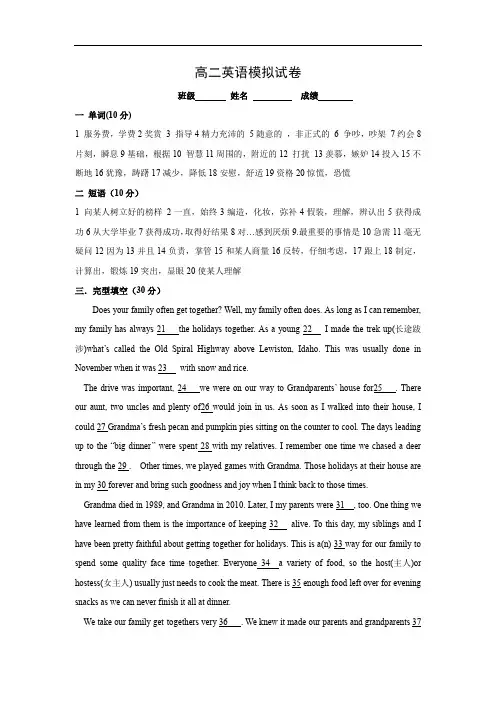
高二英语模拟试卷班级姓名成绩一单词(10分)1 服务费,学费2奖赏3 指导4精力充沛的5随意的,非正式的6 争吵,吵架7约会8片刻,瞬息9基础,根据10 智慧11周围的,附近的12 打扰13羡慕,嫉妒14投入15不断地16犹豫,踌躇17减少,降低18安慰,舒适19资格20惊慌,恐慌二短语(10分)1 向某人树立好的榜样2一直,始终3编造,化妆,弥补4假装,理解,辨认出5获得成功6从大学毕业7获得成功,取得好结果8对…感到厌烦9.最重要的事情是10急需11毫无疑问12因为13并且14负责,掌管15和某人商量16反转,仔细考虑,17跟上18制定,计算出,锻炼19突出,显眼20使某人理解三.完型填空(30分)Does your family often get together? Well, my family often does. As long as I can remember, my family has always 21 the holidays together. As a young 22 I made the trek up(长途跋涉)what’s called the Old Spiral Highway above Lewiston, Idaho. This was usually done in November when it was 23 with snow and rice.The drive was important, 24 we we re on our way to Grandparents’ house for25 . There our aunt, two uncles and plenty of26 would join in us. As soon as I walked into their house, I could 27 Grandma’s fresh pecan and pumpkin pies sitting on the counter to cool. The days leading up to the “big dinner’’ were spent 28 with my relatives. I remember one time we chased a deer through the 29 . Other times, we played games with Grandma. Those holidays at their house are in my 30 forever and bring such goodness and joy when I think back to those times.Grandma died in 1989, and Grandma in 2010. Later, I my parents were 31 , too. One thing we have learned from them is the importance of keeping 32 alive. To this day, my siblings and I have been pretty faithful about getting together for holidays. This is a(n) 33 way for our family to spend some quality face time together. Everyone 34 a variety of food, so the host(主人)or hostess(女主人) usually just needs to cook the meat. There is 35 enough food left over for evening snacks as we can never finish it all at dinner.We take our family get-togethers very 36 . We knew it made our parents and grandparents 37to see their children get along so well together. And we know they are 38 at us now because to this day, we still do that and get along well. We may have got separated by 39 , but our hearts will forever be 40 because we are family.21. A. compared B. spread C. created D. celebrated22. A. driver B. inventor C. child D. parent23. A. decorated B. faced C. covered D. replaced24. A. but B. because C. and D. so25. A. Easter B. Thanksgiving C. Halloween D. Christmas26. A. friends B. teachers C. relatives D. neighbors27. A. taste B. make C. appreciate D. smell28. A. sitting B. playing C. arguing D. fighting29. A. wood B. house C. lake D. rock30. A. memory B. excitement C. plan D. childhood31. A. changed B. gone C. killed D. moved32. A. schedules B. hobbies C. traditions D. dreams33. A. funny B. easy C. new D. great34. A. finds B. stores C. eats D. brings35. A. almost B. hardly C. usually D. never36. A. sadly B. seriously C. excitedly D. worriedly37. A. proud B. concerned C. difficult D. kind38. A. smiling B. shouting C. pointing D. looking39. A. accident B. chance C. distance D. force40. A. alive B. nice C. open D. close四.阅读下列短文,从每题所给的四个选项(A、B、C和D)中,选出最佳选项。
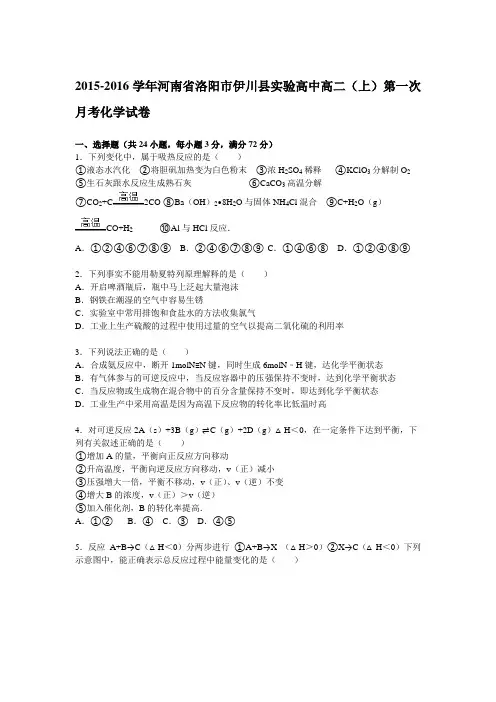
2015-2016学年河南省洛阳市伊川县实验高中高二(上)第一次月考化学试卷一、选择题(共24小题,每小题3分,满分72分)1.下列变化中,属于吸热反应的是()①液态水汽化②将胆矾加热变为白色粉末③浓H2SO4稀释④KClO3分解制O2⑤生石灰跟水反应生成熟石灰⑥CaCO3高温分解⑦CO2+C2CO ⑧Ba(OH)2•8H2O与固体NH4Cl混合⑨C+H2O(g)CO+H2⑩Al与HCl反应.A.①②④⑥⑦⑧⑨B.②④⑥⑦⑧⑨ C.①④⑥⑧D.①②④⑧⑨2.下列事实不能用勒夏特列原理解释的是()A.开启啤酒瓶后,瓶中马上泛起大量泡沫B.钢铁在潮湿的空气中容易生锈C.实验室中常用排饱和食盐水的方法收集氯气D.工业上生产硫酸的过程中使用过量的空气以提高二氧化硫的利用率3.下列说法正确的是()A.合成氨反应中,断开1molN≡N键,同时生成6molN﹣H键,达化学平衡状态B.有气体参与的可逆反应中,当反应容器中的压强保持不变时,达到化学平衡状态C.当反应物或生成物在混合物中的百分含量保持不变时,即达到化学平衡状态D.工业生产中采用高温是因为高温下反应物的转化率比低温时高4.对可逆反应2A(s)+3B(g)⇌C(g)+2D(g)△H<0,在一定条件下达到平衡,下列有关叙述正确的是()①增加A的量,平衡向正反应方向移动②升高温度,平衡向逆反应方向移动,v(正)减小③压强增大一倍,平衡不移动,v(正)、v(逆)不变④增大B的浓度,v(正)>v(逆)⑤加入催化剂,B的转化率提高.A.①②B.④C.③D.④⑤5.反应A+B→C(△H<0)分两步进行①A+B→X (△H>0)②X→C(△H<0)下列示意图中,能正确表示总反应过程中能量变化的是()A.B.C.D.6.下列有关中和热的说法正确的是()A.中和热的热化学方程式:H+(l)+OH﹣(l)═H2O(l)△H=﹣57.3 kJ/molB.准确测量中和热的实验过程中,至少需测定温度4次C.环形玻璃搅拌棒材料若用铜代替,则测量出的中和热数值偏小D.若稀酸溶液中H+与稀碱溶液中OH﹣的物质的量相等,则所测中和热数值更准确7.下列有关热化学方程式的叙述正确的是()A.已知C(石墨,s)═C(金刚石,s)△H>0.则金刚石比石墨稳定B.已知2H2(g)+O2(g)═2H2O(l)△H=﹣571.6 kJ/mol.则H2的燃烧热为285.8 kJ/mol C.已知2C(s)+O2(g)═2CO(g)△H=﹣221.0 kJ/mol.则C(碳)的燃烧热为110.5 kJ/mol D.已知2NaOH(aq)+H2SO4(aq)═Na2SO4(aq)+2H2O(l)△H=﹣114.6 kJ/mol.则该反应的中和热为114.6 kJ/mol8.断裂下列化学键需要吸收的能量分别为:H﹣H 436kJ/mol F﹣F 153kJ/mol H﹣F565kJ/mol下列说法正确的是()A.H2与F2反应的热化学方程式为:H2(g)+F2(g)═2HF(g)△H=﹣541 kJB.2 L HF气体分解成1 L H2和1 L F2吸收541 kJ的热量C.1 mol H2与1 mol F2反应生成2 mol液态HF放出的热量小于541 kJD.在相同条件下,1 mol H2与1 mol F2的能量总和大于2 mol HF气体的能量9.下列说法正确的是()A.同温同压下,H2(g)+Cl2(g)═2HCl(g)在光照和点燃的条件下△H应该不相同B.化学反应中的能量变化都表现为热量变化C.任何放热反应在常温下一定能发生D.反应物和生成物所具有的总能量决定了反应是放热还是吸热10.强酸与强碱的稀溶液发生中和反应的热效应:H+(aq)+OH﹣(aq)═H2O(l)△H=﹣57.3kJ•mol﹣1.分别向1L 0.5mol•L﹣1的NaOH溶液中加入:①稀醋酸、②浓H2SO4、③稀硝酸,恰好完全反应的热效应分别为△H1、△H2、△H3,它们的关系正确的是()A.△H1>△H2>△H3B.△H2<△H1<△H3C.△H1=△H2=△H3D.△H1>△H3>△H211.已知31g白磷变成红磷放出18.39kJ热量,下列两反应中:P4(s)+5O2(g)═2P2O5(s)△H=Q1 kJ•mol﹣14P(红,s)+5O2(g)═2P2O5(s)△H=Q2kJ•mol﹣1则下列说法中正确的是()A.Q1>Q2,白磷比红磷稳定B.Q1>Q2,红磷比白磷稳定C.Q1<Q2,白磷比红磷稳定D.Q1<Q2,红磷比白磷稳定12.在体积为2L的密闭容器内合成氨,已知在时间t内,氨的物质的量增加了0.6mol,在此时间段内,用氢气表示的平均反应速率是0.45mol•L﹣1•s﹣1,则t是()A.0.44 s B.1 s C.1.33 s D.2 s13.对于化学反应3W(g)+2X(g)=4Y(g)+3Z(g),下列反应速率关系中,正确的是()A.v(W)=3v(Z)B.2v(X)=3v(Z)C.2v(X)=v(Y)D.3v(W)=2v(X)14.一定量的锌与过量的稀H2SO4反应制取氢气,一定温度下为减慢反应速率而又不影响氢气的量,可向其中加入()A.KCl固体 B.铁粉 C.K2SO4溶液D.KNO3溶液15.下列说法正确的是()A.升高温度能使化学反应速率增大,主要原因是增加了反应物分子中活化分子的百分数B.有气体参加的化学反应,若增大压强(即缩小反应容器的体积),可增加活化分子的百分数,从而使反应速率增大C.增大反应物浓度,可增大单位体积内活化分子的百分数,从而使有效碰撞次数增大D.催化剂不影响反应活化能但能增大单位体积内活化分子百分数,从而增大反应速率16.合成氨反应:N2(g)+3H2(g)⇌2NH3(g)△H=﹣92.4kJ•mol﹣1,在反应过程中,正反应速率的变化如图.下列说法正确的是()A.t1时升高了温度B.t2时使用了催化剂C.t3时增大了压强D.t4时降低了温度17.下列反应中符合下列图象的是()A.N2(g)+3H2(g)⇌2NH5(g)△H=﹣Q1kJ•mol﹣1(Q1>0)B.2SO5(g)⇌2SO2(g)+O2(g)△H=+Q2kJ•mol﹣1(Q2>0)C.4NH5(g)+5O2(g)⇌4NO(g)+6H2O(g)△H=﹣Q3kJ•mol﹣1(Q3>0)D.H2(g)+CO(g)⇌C(g)+H2O(g)△H=+Q4kJ•mol﹣1(Q4>0)18.已知1g氢气完全燃烧生成水蒸气时放出热量121kJ,且氧气中1mol O═O键完全断裂时吸收热量496kJ,水蒸气中1mol H﹣O键形成时放出热量463kJ,则氢气中1mol H﹣H键断裂时吸收热量为()A.188kJ B.436 kJ C.557 kJ D.920 kJ19.将4mol A气体和2mol B气体在2L的密闭容器内混合,并在一定条件下发生如下反应:2A(g)+B(g)⇌2C(g),若经2s后测得C的浓度为0.6mol•L﹣1,现有下列几种说法:①用物质A表示的反应的平均速率为0.3mol•L﹣1•s﹣1②用物质B表示的反应的平均速率为0.6mol•L﹣1•s﹣1③2s时物质A的转化率为70%④2s时物质B的浓度为0.7mol•L﹣1其中正确的是()A.①③B.C.②③D.③④20.在298K、100kPa时,已知:2H2O(g)=O2(g)+2H2(g)△H1Cl2(g)+H2(g)=2HCl(g )△H22Cl2(g)+2H2O(g)=4HCl(g)+O2(g)△H3则△H3与△H1和△H2间的关系正确的是()A.△H3=△H1+2△H2 B.△H3=△H1+△H2C.△H3=△H1﹣2△H2D.△H3=△H1﹣△H221.反应N2(g)+3H2(g)2NH3(g)△H<0,在某一时间段中反应速率与反应过程的曲线关系如图,则氨的百分含量最高的一段时间是()A.t0~t1B.t2~t3C.t3~t4D.t5~t622.下列各组物质的标准燃烧热相等的是()A.碳和一氧化碳 B.1mol碳和2mol碳C.1mol乙炔和2mol碳D.淀粉和纤维素23.反应C(s)+H2O(g)⇌CO(g)+H2(g)在一个容积可变的密闭容器中进行,下列条件的改变对反应速率几乎无影响的是()①增加C的量②将容器体积缩小一半③保持体积不变,充入N2使体系压强增大④保持压强不变,充入N2使体系体积增大.A.①②B.①④C.①③D.②④24.将固体NH4I置于密闭容器中,在一定温度下发生下列反应:①NH4I(s)⇌NH3(g)+HI(g);②2HI(g)⇌H2(g)+I2(g).达到平衡时,c(H2)=0.5mol/L,c(HI)=4mol/L,则此温度下反应①的平衡常数为()A.9 B.16 C.20 D.25二、解答题(共3小题,满分0分)25.(2013秋•高港区校级期中)近年来,由CO2催化加氢合成甲醇的相关研究受到越来越多的关注.该方法既可解决CO2废气的利用问题,又可开发生产甲醇的新途径,具有良好的应用前景.已知4.4g CO2气体与H2经催化加成生成CH3OH气体和水蒸气时放出4.95kJ 的能量.(1)该反应的热化学方程式为:(2)在270℃、8MPa和适当催化剂的条件下,CO2的转化率达到22%,则4.48m3(已折合为标准状况)的CO2能合成CH3OH气体的物质的量是,此过程中能放出热量kJ.(3)又已知H2O(g)═H2O(l)△H=﹣44kJ/mol,则22g CO2气体与H2反应生成CH3OH 气体和液态水时放出热量为.(4)根据该反应特点,有利于甲醇合成的条件是.A.高压高温B.低压高温C.高压低温D.低压低温.26.(2013秋•科左后旗校级期中)密闭容器中mA(g)+nB(g)⇌pC(g),反应达到平衡,经测定增大压强P时,A的转化率随P而变化的曲线如图.则:(1)增大压强,A的转化率,平衡向移动,达到平衡后,混合物中C的质量分数.(2)上述化学方程式中的系数m、n、p的正确关系是,向上述平衡体系中加入B,则平衡.(3)当降低温度时,C的质量分数增大,则A的转化率,正反应是热反应.27.(2015秋•伊川县校级月考)在一定体积的密闭容器中,进行如下化学反应:CO2(g)+H2(g)⇌CO(g)+H2O(g)其化学平衡常数K和温度T的关系如下表:T/℃700 800 900 1000 1200K 0.6 0.9 1.0 1.7 2.6回答下列问题:(1)该反应的化学平衡常数表达式为K=.(2)该反应为反应(填“吸热”或“放热”).(3)能判断该反应是否达到化学平衡状态的依据是.A.容器中压强不变B.混合气体中c(CO)不变C.v正(H2)=v逆(H2O)D.混合气体中c(CO2)=c(CO)E.混合气体的平均相对分子质量达到一定值.2015-2016学年河南省洛阳市伊川县实验高中高二(上)第一次月考化学试卷参考答案与试题解析一、选择题(共24小题,每小题3分,满分72分)1.下列变化中,属于吸热反应的是()①液态水汽化②将胆矾加热变为白色粉末③浓H2SO4稀释④KClO3分解制O2⑤生石灰跟水反应生成熟石灰⑥CaCO3高温分解⑦CO2+C2CO ⑧Ba(OH)2•8H2O与固体NH4Cl混合⑨C+H2O(g)CO+H2⑩Al与HCl反应.A.①②④⑥⑦⑧⑨B.②④⑥⑦⑧⑨ C.①④⑥⑧D.①②④⑧⑨【考点】吸热反应和放热反应.【专题】化学反应中的能量变化.【分析】根据常见的放热反应有:所有的物质燃烧、所有金属与酸反应、金属与水反应,所有中和反应;绝大多数化合反应和铝热反应;常见的吸热反应有:绝大数分解反应,个别的化合反应(如C和CO2),少数分解置换以及某些复分解(如铵盐和强碱).【解答】解:①液态水汽化,即水由液态到气态需要吸热,但是物理变化过程,故①错误;②胆矾加热失去结晶水变成白色粉末,需要吸热,故②正确;③浓硫酸稀释放出大量的热,故③错误;④氯酸钾分解需要吸热,故④正确;⑤生石灰跟水反应生成熟石灰会放出大量的热,故⑤错误;⑥CaCO3高温分解是吸热反应,故⑥正确;⑦二氧化碳和碳反应是吸热反应,故⑦正确;⑧Ba(OH)2•8H2O与固体NH4C反应是吸热反应l,故⑧正确;⑨碳与水反应是吸热反应,故⑨正确.⑩Al与HCl反应是放热反应,故⑩错误.故选B.【点评】本题考查学生常见的放热反应和吸热反应,熟记常见的放热反应和吸热反应是解题的关键,难度不大.2.下列事实不能用勒夏特列原理解释的是()A.开启啤酒瓶后,瓶中马上泛起大量泡沫B.钢铁在潮湿的空气中容易生锈C.实验室中常用排饱和食盐水的方法收集氯气D.工业上生产硫酸的过程中使用过量的空气以提高二氧化硫的利用率【考点】化学平衡的影响因素.【专题】化学平衡专题.【分析】勒沙特列原理是如果改变影响平衡的一个条件(如浓度、压强或温度等),平衡就向能够减弱这种改变的方向移动,勒沙特列原理适用的对象应存在可逆过程,如与可逆过程无关,则不能用勒沙特列原理解释.【解答】解:A、汽水瓶中存在平衡H2CO3⇌H2O+CO2,打开汽水瓶时,压强降低,平衡向生成二氧化碳方向移动,可以用勒夏特列原理解释,故A正确;B、钢铁在潮湿的空气中容易生锈,主要发生电化学腐蚀,不能用勒夏特列原理解释,故B 错误;C、氯化钠在溶液中完全电离,所以饱和食盐水中含有大量的氯离子,氯气溶于水的反应是一个可逆反应,Cl2+H2O⇌ClO﹣+2H++Cl﹣,由于饱和食盐水中含有大量的氯离子,相当于氯气溶于水的反应中增加了大量的生成物氯离子,根据勒夏特列原理,平衡向逆反应方向移动,氯气溶解量减小,可以勒夏特列原理解释,故C正确;D、工业上生产硫酸存在平衡2SO2+O2⇌2SO3,使用过量的空气,增大氧气的浓度,平衡向正反应移动,可以提高二氧化硫的利用率,能用勒夏特列原理解释,故D正确;故选B.【点评】本题考查了勒夏特列原理的使用条件,难度不大,注意使用勒夏特列原理的前提必须是可逆过程.3.下列说法正确的是()A.合成氨反应中,断开1molN≡N键,同时生成6molN﹣H键,达化学平衡状态B.有气体参与的可逆反应中,当反应容器中的压强保持不变时,达到化学平衡状态C.当反应物或生成物在混合物中的百分含量保持不变时,即达到化学平衡状态D.工业生产中采用高温是因为高温下反应物的转化率比低温时高【考点】化学平衡状态的判断;化学平衡的影响因素.【分析】A、正逆反应速率相等的状态是平衡状态;B、有气体参与的可逆反应中,反应前后气体的系数和相等的反应,压强不会引起平衡的变化;C、化学平衡状态的特征:定:反应物或生成物在混合物中的百分含量保持不变;D、根据升高温度化学平衡向着吸热方向进行来判断.【解答】解:A、合成氨反应中,断开1molN≡N键,同时生成6molN﹣H键,正逆反应速率不一定相等,所以不一定达到平衡,故A错误;B、有气体参与的可逆反应中,当反应容器中的压强保持不变时,不一定达到化学平衡状态,如反应前后气体的系数和相等的反应,故B错误;C、当反应物或生成物在混合物中的百分含量保持不变时的状态是化学平衡状态,故C正确;D、对于吸热反应,升高温度,平衡正向移动,此时高温下反应物的转化率比低温时高,但是对于吸热反应正好相反,故D错误.故选C.【点评】本题涉及化学平衡状态的判断以及影响化学平衡移动的因素等知识,注意知识的归纳和梳理是解题的关键,难度中等.4.对可逆反应2A(s)+3B(g)⇌C(g)+2D(g)△H<0,在一定条件下达到平衡,下列有关叙述正确的是()①增加A的量,平衡向正反应方向移动②升高温度,平衡向逆反应方向移动,v(正)减小③压强增大一倍,平衡不移动,v(正)、v(逆)不变④增大B的浓度,v(正)>v(逆)⑤加入催化剂,B的转化率提高.A.①②B.④C.③D.④⑤【考点】化学平衡的影响因素.【专题】化学平衡专题.【分析】①A是固体,其量的变化对平衡无影响;②升高温度,正、逆反应速率都增大;③压强增大平衡不移动,但v(正)、v(逆)都增大;④增大B的浓度,平衡向正反应移动;⑤催化剂不能使化学平衡发生移动.【解答】解:①A是固体,增大A的量对平衡无影响,故①错误;②升高温度,v(正)、v(逆)均应增大,但v(逆)增大的程度大,平衡向逆反应方向移动,故②错误;③压强增大平衡不移动,但v(正)、v(逆)都增大,故③错误;④增大B的浓度,反应速率增大,平衡向正反应方向移动,v(正)>v(逆),故④正确;⑤使用催化剂同等程度增大正、逆反应速率,化学平衡不发生移动,B的转化率不变,故⑤错误;故选B.【点评】本题考查化学平衡的影响因素,比较基础,注意化学平衡发生移动的本质是改变条件引起正、逆速率不相等.5.反应A+B→C(△H<0)分两步进行①A+B→X (△H>0)②X→C(△H<0)下列示意图中,能正确表示总反应过程中能量变化的是()A.B.C.D.【考点】反应热和焓变.【专题】化学反应中的能量变化.【分析】根据物质具有的能量进行计算:△H=E(生成物的总能量)﹣E(反应物的总能量),当反应物的总能量大于生成物的总能量时,反应放热,当反应物的总能量小于生成物的总能量时,反应吸热,以此解答该题.【解答】解:由反应A+B→C(△H<0)分两步进行①A+B→X (△H>0)②X→C(△H <0)可以看出,A+B→C(△H<0)是放热反应,A和B的能量之和大于C,由①A+B→X (△H>0)可知这步反应是吸热反应,X→C(△H<0)是放热反应,故X的能量大于A+B;A+B的能量大于C;X 的能量大于C,图象B符合,故选B.【点评】本题为图象题,主要考查了物质的能量分析应用,化学反应的能量变化、分析,题目难度不大,注意反应热与物质总能量大小的关系判断.6.下列有关中和热的说法正确的是()A.中和热的热化学方程式:H+(l)+OH﹣(l)═H2O(l)△H=﹣57.3 kJ/molB.准确测量中和热的实验过程中,至少需测定温度4次C.环形玻璃搅拌棒材料若用铜代替,则测量出的中和热数值偏小D.若稀酸溶液中H+与稀碱溶液中OH﹣的物质的量相等,则所测中和热数值更准确【考点】中和热.【分析】A.氢离子和氢氧根离子的状态为“aq”;B.准确测量中和热的实验过程,一般要测三次温度;C.铜导热性能强于玻璃;D.为了使反应充分进行,应使一方过量,而不是使二者物质的量相等.【解答】解:A.中和热的热化学方程式为H+(aq)+OH﹣(aq)=H2O(l)△H=﹣57.3 kJ/mol,故A错误;B.准确测量中和热的实验过程,一般要测三次温度,故B错误;C.中和热测定实验成败的关键是保温工作,金属铜的导热效果好于环形玻璃搅拌棒,所以测量出的中和热数值偏小,故C正确;D.中和反应热的测定应使盐酸充分反应,需加入稍过量的NaOH溶液减少盐酸的挥发,减少误差,故D错误;故选C.【点评】本题考查了中和热的定义和中和热的测定实验,注意测定中和热的关键是保温,题目难度不大.7.下列有关热化学方程式的叙述正确的是()A.已知C(石墨,s)═C(金刚石,s)△H>0.则金刚石比石墨稳定B.已知2H2(g)+O2(g)═2H2O(l)△H=﹣571.6 kJ/mol.则H2的燃烧热为285.8 kJ/mol C.已知2C(s)+O2(g)═2CO(g)△H=﹣221.0 kJ/mol.则C(碳)的燃烧热为110.5 kJ/mol D.已知2NaOH(aq)+H2SO4(aq)═Na2SO4(aq)+2H2O(l)△H=﹣114.6 kJ/mol.则该反应的中和热为114.6 kJ/mol【考点】热化学方程式.【专题】计算题;守恒思想;类比迁移思想;燃烧热的计算.【分析】A、物质具有的能量越低越稳定;B、根据燃烧热的概念:1mol物质完全燃烧生成最稳定的氧化物所放出的能量来回答;C、根据燃烧热的概念:1mol物质完全燃烧生成最稳定的氧化物所放出的能量来回答;D、根据中和热的概念:氢离子与氢氧根离子生成1mol水所放出的热量;【解答】解:A、根据C(石墨,s)═C(金刚石,s)△H>0,则石墨的能量低于金刚石的能量,物质具有的能量越低越稳定,所以金刚石不如石墨稳定,故A错误;B、因燃烧热在某一温度和压强下lmol某物质完全燃烧生成稳定氧化物时所释放出的热量,所以H2的燃烧热为285.8kJ•mol﹣1,故B正确;C、因燃烧热在某一温度和压强下lmol某物质完全燃烧生成稳定氧化物时所释放出的热量,碳完全燃烧应生成二氧化硫,故C错误;D、根据中和热的概念:氢离子与氢氧根离子生成1mol水所放出的热量,所以该反应的中和热为57.3 kJ/mol,故D错误;故选B.【点评】本题考查学生燃烧热的含义以及中和热的概念、反应的热效应方面的知识,属于综合知识的考查,难度中等.8.断裂下列化学键需要吸收的能量分别为:H﹣H 436kJ/mol F﹣F 153kJ/mol H﹣F565kJ/mol下列说法正确的是()A.H2与F2反应的热化学方程式为:H2(g)+F2(g)═2HF(g)△H=﹣541 kJB.2 L HF气体分解成1 L H2和1 L F2吸收541 kJ的热量C.1 mol H2与1 mol F2反应生成2 mol液态HF放出的热量小于541 kJD.在相同条件下,1 mol H2与1 mol F2的能量总和大于2 mol HF气体的能量【考点】反应热和焓变.【分析】A、反应热的单位为kJ/mol.根据反应热△H=反应物总键能﹣生成物总键能计算反应热,书写热化学方程式;B、气体所处的状态不确定;C、同一物质气态的能量比液态的能量高,结合能量守恒判断;D、根据键能,判断反应是放热反应还是吸热反应,反应物的总能量高于生成物的总能量,反应为放热反应,反应物的总能量小于生成物的总能量,反应为吸热反应.【解答】解:A、反应热的单位为kJ/mol,各化学键键能:H﹣H436kJ/mol;F﹣F 153kJ/mol;H﹣F 565kJ/mol,所以对于反应H2(g)+F2(g)=2HF(g)的反应热为△H=436kJ/mol+153kJ/mol﹣2×565kJ/mol=﹣541kJ/mol,该反应的热化学方程式为于H2(g)+F2(g)=2HF(g)△H=﹣541kJ/mol,故A错误;B、由A可知2molHF分解,吸收的热量为541kJ,气体所处的状态不确定,不清楚2L氟化氢的物质的量是多少,无法确定吸收热量,故B错误;C、由A可知1molH2与1molF2反应生成2molHF(g),放出的热量为541kJ,液态HF的能量比气体HF的能量低,所以1molH2与1molF2反应生成2mol液态HF放出热量大于541kJ,故C错误;D、由A可知H2与F2反应生成HF为放热反应,所以在相同条件下,1molH2与1molF2的能量总和大于2molHF气体的能量,故D正确.故选D.【点评】本题考查热化学方程式的书写与意义、反应热与化学键及物质能量关系、物质状态与能量关系,难度不大,注意基础知识的理解与掌握.9.下列说法正确的是()A.同温同压下,H2(g)+Cl2(g)═2HCl(g)在光照和点燃的条件下△H应该不相同B.化学反应中的能量变化都表现为热量变化C.任何放热反应在常温下一定能发生D.反应物和生成物所具有的总能量决定了反应是放热还是吸热【考点】反应热和焓变;化学平衡的影响因素.【分析】A、△H与反应的条件无关;B、化学反应的能量变化除了热量外,还有光能等形式的能量转化;C、有些放热反应必须加热才能反应;D、依据化学反应前后能量守恒判断反应吸热放热.【解答】解:A、同温同压下,H2(g)+Cl2(g)═2HCl(g)在光照和点燃条件下的△H 相同,故A错误;B、化学反应的能量变化除了热量外,还有光能等形式的能量转化,如镁条燃烧放热发光,故B错误;C、有些放热反应必须加热才能反应,如燃烧反应,常温下不反应,故C错误;D、反应物和生成物所具有的总能量决定了反应是放热还是吸热,若反应物总能量大于生成物总能量,则反应是放热反应,反之为吸热反应,故D正确;故选D.【点评】本题考查了化学能与热能的转化关系,主要考查反应条件与反应热量变化的关系,能量守恒判断反应的吸热放热.10.强酸与强碱的稀溶液发生中和反应的热效应:H+(aq)+OH﹣(aq)═H2O(l)△H=﹣57.3kJ•mol﹣1.分别向1L 0.5mol•L﹣1的NaOH溶液中加入:①稀醋酸、②浓H2SO4、③稀硝酸,恰好完全反应的热效应分别为△H1、△H2、△H3,它们的关系正确的是()A.△H1>△H2>△H3B.△H2<△H1<△H3C.△H1=△H2=△H3D.△H1>△H3>△H2【考点】反应热的大小比较.【专题】化学反应中的能量变化.【分析】根据稀的强酸与强碱生成1molH2O放出的热量为中和热,注意弱电解质的电离吸热,浓硫酸溶于水放热来解答.【解答】解:因强酸与强碱的稀溶液发生中和反应的热效应:H+(aq)十OH﹣(aq)=H2O△H=一57.3kJ/mol,分别向1L 0.5mol/L的NaOH溶液中加入:①稀醋酸;②浓H2SO4;③稀硝酸,因醋酸的电离吸热,浓硫酸溶于水放热,则恰好完全反应时的放出的热量为②>③>①,所以△H2<△H3<△H1,故选D.【点评】本题考查中和热,明确中和热的概念及弱电解质的电离、浓硫酸溶于水的热效应即可解答,难度不大.11.已知31g白磷变成红磷放出18.39kJ热量,下列两反应中:P4(s)+5O2(g)═2P2O5(s)△H=Q1 kJ•mol﹣14P(红,s)+5O2(g)═2P2O5(s)△H=Q2kJ•mol﹣1则下列说法中正确的是()A.Q1>Q2,白磷比红磷稳定B.Q1>Q2,红磷比白磷稳定C.Q1<Q2,白磷比红磷稳定D.Q1<Q2,红磷比白磷稳定【考点】反应热和焓变.【分析】根据能量越低越稳定及其盖斯定律的实质应用判断,可以利用题干所给反应和热量变化,合并得到白磷转化为红磷的热量变化分析判断.【解答】解:根据题意,知道①P4(s)+5O2(g)═2P2O5(s)△H=Q1 kJ•mol﹣1;②4P (红,s)+5O2(g)═2P2O5(s)△H=Q2kJ•mol﹣1①﹣②得到P4(s)=4P(红,s)△H=Q1﹣Q2kJ•mol﹣1已知1mol白磷变成1mol红磷放出18.39KJ的热量,所以白磷能量低稳定,△H=Q1﹣Q2>0,则Q1>Q2.故选A.【点评】本题考查了反应的热效应的计算应用,关键是盖斯定律的含义和实际应用.12.在体积为2L的密闭容器内合成氨,已知在时间t内,氨的物质的量增加了0.6mol,在此时间段内,用氢气表示的平均反应速率是0.45mol•L﹣1•s﹣1,则t是()A.0.44 s B.1 s C.1.33 s D.2 s【考点】反应速率的定量表示方法.【分析】利用速率之比等于化学计量数之比计算出v(NH3),再根据t=计算时间.【解答】解:H2表示的平均速率v(H2)=0.45mol/(L∙s),利用速率之比等于化学计量数之比,所以v(NH3)=v(H2)=×0.45mol/(L∙s)=0.3mol/(L∙s),氨的浓度增加了0.6mol/L,即△c(NH3)=0.6mol/L,所以反应所经历的时间为=2s,故选:D.【点评】本题考查化学反应速率的有关计算,难度不大,注意对公式的理解与灵活运用.13.对于化学反应3W(g)+2X(g)=4Y(g)+3Z(g),下列反应速率关系中,正确的是()A.v(W)=3v(Z)B.2v(X)=3v(Z)C.2v(X)=v(Y)D.3v(W)=2v(X)【考点】化学反应速率和化学计量数的关系.【专题】化学反应速率专题.【分析】根据化学反应速率是用单位时间内反应物浓度的减少或生成物浓度的增加来表示的,利用化学反应中化学反应速率之比等于其化学计量数之比来解答.【解答】解:A、由化学计量数可知,v(W):v(Z)=1:1,故A错误;B、由化学计量数可知,v(X):v(Z)=2:3,故B错误;C、由化学计量数可知,v(X):v(Y)=2:4=1:2,即2v(X)=v(Y),故C正确;D、由化学计量数可知,v(W):v(X)=3:2,故A错误;故选C.【点评】本题主要考查化学反应速率和化学计量数的关系,明确化学反应速率之比可由化学反应中的化学计量数直接观察得出是解答的关键.14.一定量的锌与过量的稀H2SO4反应制取氢气,一定温度下为减慢反应速率而又不影响氢气的量,可向其中加入()A.KCl固体 B.铁粉 C.K2SO4溶液D.KNO3溶液【考点】化学反应速率的影响因素.【专题】化学反应速率专题.【分析】一定温度下为减慢反应速率,可减小H+的浓度,一定量的锌与过量的稀H2SO4反应,如果硫酸过量,不影响氢气的量,所加入物质不能影响减少Zn或H+的物质的量,以此进行判断.【解答】解:A.加入氯化钾,溶液中H+的浓度不会变化,反应速率几乎无变化,故A错误;B、加入铁粉,生成更多的氢气,不符合题意,故B错误;C.加入K2SO4溶液,相当于加入水,会使得溶液中H+的浓度减小,反应速率减慢,故C 正确;D.加入硝酸钾溶液,溶液中会存在硝酸,消耗金属铁生成的是一氧化氮,会影响氢气的量,故D错误.故选C.【点评】本题考查化学反应速率的影响因素,题目难度不大,注意题目要求,为解答该题的关键,学习中注意影响化学反应速率的外界因素.15.下列说法正确的是()A.升高温度能使化学反应速率增大,主要原因是增加了反应物分子中活化分子的百分数B.有气体参加的化学反应,若增大压强(即缩小反应容器的体积),可增加活化分子的百分数,从而使反应速率增大C.增大反应物浓度,可增大单位体积内活化分子的百分数,从而使有效碰撞次数增大D.催化剂不影响反应活化能但能增大单位体积内活化分子百分数,从而增大反应速率【考点】化学反应速率的影响因素.【专题】化学反应速率专题.【分析】温度、催化剂可影响活化分子的百分数,而浓度、压强只改变单位体积活化分子的数目,不改变百分数,另外,催化剂可降低反应的活化能.【解答】解:A.升高温度,可增加反应物分子中活化分子的百分数,使反应速率增大,故A正确;。
河南省洛阳市伊川县第二高级中学高二英语测试题含解析一、选择题1. He is very sick. I insist that a doctor __________ immediately.A. has been sent forB. sends forC. will be sentfor D. be sent for参考答案:D略2. There is a wide _____ of moon cakes to choose from in China when Mid Autumn Day is coming .A. extensionB. mixtureC. varietyD. combination参考答案:C3. Christmas is _____ special holiday when _______ whole family are supposed to get together.A. the, theB. a, aC. the, aD. a, the参考答案:D4. When you come across a new word, you can _________ the dictionary. Which is NOT true?A. look upB. refer toC. turn toD. look it up in参考答案:A5. —I think you should phone Jenny and say sorry to her.—.It was her fault.A.No way B.Not impossible C.No chance D.Not at all参考答案:A略6. With the development of E-books, people can have easy to quantities of books online.A. desireB. privilegeC. wayD. access 参考答案:D7. Tom is similar ____ height ____ Peter though they are of different ages.A. to, inB. to, toC. in, inD. in, to参考答案:D略8. It surprised us all ______ good manners the monitor had.A. thatB. whichC. whatD. how参考答案:C略9. This is perhaps one of ___ most important reasons why so many people write ___ poetry.A. a ; theB. the ;theC. the ; /D. a ; /参考答案:C10. It rained heavily in the south, serious flooding in several provinces.A. causeB. having causedC. causingD. to cause参考答案:C11. ________that Maric was able to set up new branches elsewhere.A. So successful her business wasB. So successful was her businessC. So her business was successfulD. So was her successful business参考答案:B12. The brave soldiers were determined to save all the people ____ in the field.A. trappedB. being trappedC. were trappedD. trapping参考答案:A13. You can only be sure of ____ you have at present; you cannot be sure of something ____ you might get in the future.A that, whatB what, /C what, whichD / , that参考答案:B略14. The agent was about to sign his name to the document __________, to our surprise, a stranger broke in to prevent him.A. whileB. asC. whenD. until参考答案:C15. The little girl is walking along the beach, _____, occasionally bending down to pick up a beautiful seashell.A. happily and joyfullyB. happily and joyfulC. happy and joyfullyD. happy and joyful参考答案:D二、短文改错16. 假定英语课上老师要求同桌之间交换修改作文,请你修改你同桌写的以下作文。
伊川县实验高中2015-2016学年度上期第一次月考高二地理试题(考试范围:必修三1-4章;)第Ⅰ卷(选择题 35题共70分)一、选择题。
(在每小题给出的四个选项中,只有一项符合题目要求。
)1.关于我国三大自然区分布的叙述,正确的是()A.都兼跨内、外流区 B.都兼跨地势三级阶梯C.都兼跨四类干湿区 D.都兼跨四个温度带2.有关中国自然区域内部差异及其对人类活动影响的叙述,正确的是A.东北地区因降水较少,故只能发展一年一熟的农业B.秦岭—淮河以南的华中区、华南区因夏季雨热同期,故它们均可发展水田农业C.西北干旱半干旱区的东部因距海相对较近,降水相对较多,故可适量发展水田农业 D.青藏高寒区只有海拔较低的河谷地带有农业的发展3下列关于长江三角洲和松嫩平原共性的叙述,正确的是( )①都位于平原地区②都位于我国的东部季风区③都位于第三阶梯④雨热同期A.①②③B.②③④C.①③④D.①②③④4.下列荒漠与其主要成因的对应关系中,不正确的是()A.拉丁美洲南端东岸地区的荒漠——地形B.阿拉伯半岛上的荒漠——受副热带高气压带和信风带控制C.南美洲西海岸的热带荒漠逼近赤道地区——地形D.我国塔里木盆地中的荒漠——深居内陆读图1,我国西北部内陆两地景观示意图回答5-6题。
图15.甲地形成其原因可能是A.由于过度开采地下水导致形成地下水漏斗区B.由于干旱地区地下水含盐量高,使植物不能生存C.由于风力侵蚀形成风蚀洼地D.水井周围地区农牧业活动较频繁而导致地表植被破坏6.在乙地区,可能反映该地区绿洲萎缩的现象有A.沙尘暴频度减少 B.土壤有机质增加,土壤紧实度下降C.土壤盐碱度升高 D.生物生产能力提高读图2,完成7-9题。
7.图中甲、乙、丙、丁区域( )A.是按照综合指标划分的B.边界有实有虚C.属不同层次的区域D.相互间差异大8.有关区域自然环境特征的叙述,正确的是( )A.甲区域光照充足而热量不足B.乙区域降水少但季节变化大C.丙区域河流长而流量变化小D.丁区域土层厚但土壤肥力低9.实时获取丙区域植被生长状况的信息,所应用的地理信息技术主要是( )A.地理信息系统B.遥感C.全球定位系统D.数字地球图3是低、中、高三个不同纬度的自然带(生态系统)物质流动示意图(图中圆圈的大小表示所储存养分百分比的多少,箭头的粗细表示物质养分流的大小)。
丰城中学2015-2016学年上学期高二周练英语试卷(4-36班)命题:葛雪荣审题:高二英语备课组2015.12.09一. 完形填空Reading and writing __1__ is a very personal experience. Poets use language as a way of __2__ their feelings,whether positive ones of love, happiness and hope,or negative feelings like __3__ and fear. Poems candescribe the beauty of nature, a person, a dream or a memorable event. Most __4__ have tried writing poetry at some time,for example at school. For children,it is a good way to explore language and have __5__ with words as well as to express themselves.But teachers and psychologists have found another use for poetry as a form of therapy(治疗) to help people with problems.__6__ are benefits for people of all different backgrounds and ages. Writing poetry can help people deal with __7__ in their lives—death or feelings of sadness,drug or alcohol problems or serious illness. By writing down your feelings,__8__ can learn to understand yourself better and give yourself a voice if you feel you are being ignored. A poem might be a way of telling someone something when you do not feel able to talk about it __9__.And just because people are __10__ or having difficulties in their lives, it doesn'tmean they have lost their sense of humour. Poems__11__ as therapy can be funny too, as laughter is also considered to be very good medicine. Students at a special school in Dudley,in England,read1.A. poemC.poetB..the poemsD.poetry 2.A. expressing C.expressesB.expressionD.expressed 3.A. excitementC.darknessB.angerD.joy 4.A. peopleC.writersB.studentsD.teachers 5.A. gameC.smileB.funD.food 6.A. ThereC.ThisB.ItD.That 7.A. branchesC.exercisesB.changesD.lines 8.A.IC.sheB.theyD. you9.A.shoulder toshoulderC.hand in handB.face to faceD.eye to eye10.A. hungryC.thirstyB.illD. happy11.A. saidC.seenB.spokenD.written12. A. some timeC. every dayB. everydayD.sometimeand write poems __12__.Their reason for writing poems is not just to __13__ creative. All of them have problems. Some of them have long-term __14__ conditions,such as cancer, while others have personality disorders or psychological problems. By writing poems students are growing __15__ self-confidence. The poems provide a channel through __16__ they can communicate with the world,and express their feelings. They __17__ help them to recognize and explore their problems and to develop apositive attitude to life.But the poems are helping __18__ people, too. The school has collected some of the students' poems and published them in a book which is __19__ to raise funds for a local hospital. The book has proved very popular,giving students __20__ sense of achievement.13.A. /C. beB. isD. are14.A.saltyC.naturalB.scientificD.medical 15.A.inC.fromB.onD.at 16. A. whoC.thatB.whichD.when 17. A. eitherC.yetB.tooD.also 18. A. anotherC.otherB.the otherD.the others 19. A. sellsC.being soldB. sellD. beingselling20. A. aC./B.anD.the二.阅读理解:ARome wasn't built in a day, and the Internet didn't come out of a golden egg. Many of today's creations were born of people who had creative ideas, but who did not stop at simply having an idea. They took one brick of capital (资本), another brick of knowledge, perhaps a brick or two of family and friends, and built their empires brick by brick.If you want to build an online empire, you cannot settle for simply having a website full of articles, or a website full of pictures—there are already thousands of sites like that,so you need to come up with something new and creative.So if you are starting to build something up, ask yourself: what do you really want to do, and what are you really good at? Believe it or not, you can make money at something that you are an expert in, and you need to know what that is.Remember, having an online empire does not mean that you have to do it alone.You can take your_friends along with you.Having a friend advertise your services online is a good way to attract more visitors to your empire.Building an online empire, you will have to be prepared to not only come up with creative ideas, but to carry your ideas through.Talk to people who have already succeeded in building their own empires.Talk to people who are struggling.Join a mailing list that will help you get through your struggle to achieve your goal.As you move forward, you will find that you can help other people, and you will have a good many stories to tell—not to mention a lot of money in the bank.If you learnhave enough money to retire on.21.Which of the following would be the BEST title for this passage?A.Never get addicted to the InternetB.Building an online empire of your ownC.How to get help from an online empireD.How to offer help through an online empire22.The proverb “Rome wasn't built in a day” applies to a situation where________.A.expert knowledge is badly neededB.you are short of money at the beginningC.online wealth has to be gained bit by bitD.family and friends will oppose your idea23.Which of the following is NOT mentioned as something that will help you make money online?A.Creative ideas. B.Expert knowledge.C.Relationship resources. D.Skills of making bricks.24.In the 4th paragraph “your friends” are mentioned because________.A.they can buy what you are sellingB.they can help make your website popularC.your friends know more about the WebD.you have a good relationship with your friends25.Joining a mailing list is a good way to________.A.get a lot of helpB.write many emailsC.D.talk people into purchasing your productBLong ago,poems were recited out loud instead of being written down. When the Greeks first started the Olympics,they held poetry contests as well as athletic competitions.Now,poetry competitions have been revived(恢复).This year 120,000 high school students competed in the first Poetry Out Loud National Recitation Contest,performing poems from memory for $100,000 in prizes.The first competitions were held in classrooms. The winners went on to school-wide contests,and then they competed in city and state competitions. Finally,the 50 state champions,along with the District of Columbia champion came to Washington,D.C.for the last showdown. After the 51 champions competed against one another,12 went on to the finals. Then the field was narrowed to five. The final five had one last chance to“perform”a poem. The overall champ,Jackson Hille,a high school senior from Ohio,won a $20,000 scholarship.The National Endowment for the Arts and the Poetry Foundation started Poetry Out Loud because they realized that hearing a poem performed is a different experience from reading it on a page.It's not just a matter of saying the words in the right order. It's the tone of voice,the pauses,the gestures,and the attitude of the person performing that bring the words to life.“Each time we hear somebody recite a poem,we find something fresh and interesting about it,”says Na tional Public Radio Broadcaster Scott Simon,master of ceremonies for the finals. Hearing it in a new voice offers something new to the listener.Not only do the people hearing poems have a new experience,memorizing and presenting poems helps the participants(选手)understand those poems in a new way. Another benefit of a competition such as Poetry Out Loud is that the participants learn public-speaking skills that can help them for life.26.From the first paragraph,we can know ________.A.the Greeks were the first to write poemsB.the Olympics used to start with poem recitingC.poems were spread orally in the pastD.athletes were asked to recite poems before competing27.How many rounds of competitions did the champions take before they went to Washington,D.C.?A.Three. B.Four. C.Five. D.Six.28.According to the passage,hearing a poem recited by different people can ________.A.bring a new life to listeners B.help listeners find their interestC.make listeners learn the words D.offer something new to listeners29.One benefit the participants get from poem recitation competitions is that they can ________.A.become skilled in speaking in public B.write good poems themselvesC.change their attitudes towards life D.make friends with many great poets30.What's the main idea of the passage?A.Reciting poems improves your memory. B.Remembering a lot of poems is fun.C.Poets have a great time. D.Poetry competitions freshen us up.三. 七选五Shopping is not as simple as you may think! There are all sorts of tricks at play each time we reach out for that particular brand of product on the shelf.31 Health foods are packaged in greens, yellows or browns because we think of these healthy colors. Ice cream packers are often blue and expensive goods, like chocolates, are gold or silver.32 Recently, some kind of pain killer was brought out, but researchers found it didn’t sell well, because the color made the product look weak and ineffective. Eventually, it came on the market in a dark blue and white package—because we think of blue as safe, and white as calm.33 But quite often a bottle doesn’t contain as much as it appears to.It is believed that the better-known companies spend, on average, 70 percent of the total cost of the product itself on packaging!The most successful producers know the truth: 34 The founder of Pears soup, who for 25 years has used pretty little girls to promote their goods, came to the conclusion: “ 35 ”A. It’s not enough to have a good product.B. Coloring, for example, varies according to what the producers are trying to sell.C. Any fool can make soup, but it takes a genius to sell it.D. The colors tricked the customers into shopping.E. The size of a product can attract a shopper.F. A good product is an advantage.G. The colors turned the customers off.四. 单词拼写36.Have you got any ________(具体的)proposals as to what we should do?37.Don't get upset. I was only ________(逗着玩).38.The source of the river lies in Tibet and its ________(支流)cover much of the country.39.We are facing two ________(引起矛盾的)suggestions so we don't know what to do next.40.Our plan needs to be ________(灵活的)enough to meet the needs of everyone.41.A generator ________(转变)mechanical energy into electricity.42.We have turned this school into a________(托儿所).43.The murders all seem to follow a similar________(模式).44.We didn't know how they________(运送)these stones over 380 miles without modern machines.45.________(最终),the sky cleared up and we went to the beach.五:语法填空We high school students do have some growing pains, but we can get rid of them correctly and wisely. 46 , some of us are upset 47 their body styles and looks. It’s unnecessary and it’s not important at all. We needn’t care about it. It is one’s inner beauty 48 matters. Second, we sometimes seem to be misunderstood 49 our teachers, parents and classmates. 50 (face) with this, we can find a proper time to have a heart-to-heart talk with them, trying to remove the 51 (understand). Some of us have fewer friends. I think being open-minded and friendly will do you good. Third, we may fall behind others, 52__ makes us stressed. Actually we can encourage 53 to work efficiently, full of_____54___(determine). At last, some of us don’t have m uch pocket money, so they feel unhappy. Isn’t it strange? So long as we have some, that’s enough. And we can learn 55 tospend money.六:短文改错:Once there lived a man who was such lazy that no job was fit him. In order to make a living he went to a neighbor of him for help one day. A neighbor advised to him to be a cemetery caretaker as it was the easier job one could find. The lazy man delighted and soon became a cemetery caretaker. And to everyone’s surprise he gave up his job three days before he got it. “It’s unfair,” he said to the neighbor angry. “ In the cemetery all the others are lying still when I am the only one who has to stand..”周练答题卡单词拼写36_________ 37_________ 38________ 39_________ 40_________41_________ 42_________ 43________ 44_________ 45_________语法填空46_________ 47_________ 48________ 49_________ 50_________51_________ 52_________ 53________ 54_________ 55_________请修改下面的短文。
前一高2015-2016学年高二英语期中考试试题第一部分:听力(1----20题)略第二部分:阅读理解(共10小题;每小题2分,满分20分)阅读下列短文,从每题所给的四个选项(A 、B 、C 和D )中,选出最佳选项,并在答题卡上将该项涂黑。
ADid you know the meaning of a word may change over time? Many English words we know now had different meanings a long time ago. One example is the word nice.Around the year 1300, nice was first used in English to mean “stupid”. Two hundred years later, nice began to carry a “better” meaning. If people said a book was written nicely, they meant the book was written “clearly” or “carefully”, not “stupidly”. After 1800, nice began to take its meaning like “kind” or “friendly”. Since then, people have thought of nice as a word with good meanings.A good change of a word’s meaning like this example of nice is called AMELIORA TION. Though we don’t use nice to mean “stupid” any more, it is fun to know how much a word’s meaning can change from its start!For more examples of AMELIORATION, see next page.21. 1300 years ago, a “nice person” was believed to be_________.A. carefullyB. friendlyC. cleverD. stupid22. What is the second paragraph mainly about?A. What nice used to mean.B. How the meaning of nice changed over time.C. How long nice has been used .D. Why the meaning of nice changed.23. AMELIORATION means a word’s meaning_____.A. changes from bad to goodB. can change from its startC. changes from good to badD. remains the same over a long timeBLong long ago, there lived in Greece a king named Midas. He was a greedy man and loved gold better than anything else in the world.One day, he asked a god to give him more gold. The god decided to punish him and said, “Your wish is granted already. Everything you touch will turn to gold.”Midas was very happy when he heard this. The next morning, he got up early to test his skill. When he touched his bed, it turned to gold. “Gold!” cried Midas, laughing like a little boy, “ It works!”Not only stones, flowers and the furniture in his house turned to gold, but, when he sat down to table, so did the food he ate and the water he drank. He was unhappy now. Just then his daughter ran up to him. Midas touched her hand. At once she became a gold statue(雕像)!At last, he begged the god to free him from his wish. “Go to the river and bathe in it,” the god said. So Midas did, and the water took away his golden touch.24. The god decided to punish Midas because he was ___________.A. lazyB. proudC. greedyD. unhappy25. Which is the correct order according to the story?a. Midas became the king of Greece.b. His daughter turned into gold.c. Midas was happy with his skill.d. The god freed him from his wish.e. Midas asked god for more gold.A. d—e—c—b---aB. c—a—c—d—bC. a—e—b—c—dD. a—e—c—b—d26. What can we learn from the story?A. It’s the early bird that catches the worm.B. Gold does not always bring happiness.C. Don’t put all your eggs in one basket.D. A bird in hand is worth two in the forest.CIt’s not easy being a teenager ---nor is it easy being the parent of a teenager.You can make your child feel angry, hurt or misunderstood by what you say without realizing it yourself.It is important to give your child the space he needs to grow while gently letting him know that you’11 still be there for him when he needs you.Expect a lot from your child,just not everything.Except for health and safety problems,such as drug use or careless driving,consider everything else open to discussion.If your child is unwilling to discuss something,don’t insist he tell you what’s on his mind.The more you insist,the more likely that he’11 clam up.Instead,let him attempt to solve things by himself. At the same time,remind him that you’re always there for him should he seek advice o r help.Show respect for your teenager’s privac y.Never read his mail or listen in on personal conversations.Teach your teenager that the family phone is for the whole family. If your child talks on the family’s telephone for too long,tell him he can talk for l5 minutes,but then he must stay off the phone for at least all equal period of time.This not only frees up the line so that other family members can make and receive calls,but teaches your teenager moderation(节制).Or if you are open to the idea,allow your teenager his own phone that he pays for with his own pocket money or a part-time job.27.The main purpose of the text is to tell parents .A. How to get along with a teenagerB. How to help a teenager grow upC. How to understand a teenagerD. How to respect a teenager28. What does the phrase "clam up" in Paragraph 2 probably mean?A. refuse to talkB. show respectC. become excitedD. seek help29. The last paragraph is about how to teach a teenagerA. to pay for his own telephoneB. to use the phone in a sensible wayC. to share the phone with friendsD. to answer the phone quickly30. What should parents do in raising a teenager according to the text?A. Not allow him to learn driving or take drugs.B. Let him have his own telephone.C. Give him advice only when necessary.D. Not talk about personal things with him.第二节(共5小题;每题2分,满分10分)根据短文内容,从短文后的选项中选出能填入空白处的最佳选项。
- 1 - 2015-2016学年高二第一次月考英语试卷 I卷 第一部分听力(共两节,满分30分) 第一节(5小题,每小题1.5分,满分7.5分) 听下面5段对话。每段对话后有一个小题,从题中所给的ABC三个选项中选出最佳选项,并标在试卷的相应位置。听完每段对话后,你都有10秒钟的时间来回答有关小题和阅读下移小题。每段对话仅读一遍。 1. How will they go to New York? A. By car B. By bus C. By air 2. What are the two speakers mainly talking about? A. the man’s birthday gifts.B. The man’s relatives. C. The woman’s birthday gifts. 3. Where are most probably the two speakers? A. At a store B. At home. C. At a fashion show. 4. what will the woman do next? A. listen to news. B. Go to the park.C.Talk at home. 5. What is the woman doing? A. Checking in at a hotel.B. Seeing a doctor.C. Asking for direction. 第二节(共15小题;每小题1.5分,满分22.5分)听下面5段对话或独白。每段对话或独白后有几个小题,从题中所给A、B、C三个选项中选出最佳选项,并标在试卷的相应位置。听每段对话或独白前,你将有时间阅读各个小题,每小题5秒钟;听完后,各小题给出5秒钟的作答时间。每段对话或独白读两遍。 听第6段材料,回答第6、7题。 6. Whom will the woman spend this afternoon with? A. Her cousin. B. The man. C. The man’s cousin. 7. What do they agree to do in the end? A. Go to a movie this afternoon. B. Hang out together this afternoon. C. Go to a movie tomorrow afternoon. - 2 -
听第6段材料,回答第8、9题。 8. What does the man’s father like doing? A. Playing ping-pong.B. Going to the gym.C. Playing football. 9. What will the woman do tomorrow? A. Watch movies at home. B. surf the Internet.C. paly ping-pang 听第8段材料,回答第第10至12题。 10. What is the man looking for? A.A list B. His wallet.C. The cat. 11. Where does the man find what he needs? A. In a drawer.B. In the garage.C. Under a pillow. 12. How will the man go to the supermarket? A. Drive Mike’s car.B. Drive his own car.C. On foot. 听第9段材料,回答第13至16题。 13. who is the woman speaking to? A. a school newspaper journalist.B. a radio program host. C. A TV show host. 14. What happened to that girl? A. She fell down the stairs.B. she had a traffic accident. C. she fell over on the ground. 15. How did the woman react when she realized what had happened? A. she shouted for help.B. she took the girl to hospital. C. she stayed calm and called 911. 16. What does the woman think of taking a first-aid course? A. casual B. helpless C. necessary 听第10段材料,回答第17至20题。
17. What does the woman want Mike to do? A. see her off at the airport.B. Give her a ride.C. Call her a taxi. 18. When will the woman leave for the airport tomorrow morning? A. At 5:00 B. At 6:00 C. At 7:00 - 3 -
19. What’s the weather like today? A. Fine B. Cloudy C. Rainy 20. What did the woman do in the country? A. She travelled. B. She visited the man. C. She taught here. 第二部分完形填空(一)(共20小题;每小题1.5分,满分30分) 阅读下面短文,从短文后各题所给的四个选项中,选出最佳选项,并写到答题卡上。 Once upon a time, there was a small village. This village had a strange _2_1__. Each spring, any boy that had reached the age of majority(成年年龄)was given land and money to __2_2__ a home. The boy had to _2_3__ his home before winter. If his home failed to survive the winter weather, the villagers could not help him in any way. One spring, Paul and Marc reached the age of majority. They _2_4__ their land and money and decided to search nearby villages for __25__ on building their homes. In each village, they found the nicest __26__ and talked to the owners. Each owner gladly offered __27__. After Marc saw several homes, he _2_8__ the best ideas and went back to his own land. Paul, __29__, continued collecting more ideas. Soon he had so many great ideas that he began to __30__ some of them. But he always believed he could find even better ideas in the next village. Marc began building his home. He had several __31__ starts, but his home gradually rose from his land. By fall, Marc finished his home. It wasn’t __32__, but it was strong and he would improve it later. The first snow came and Paul, realizing he was running out of __33__, rushed back to his land. He built the best home he could in the time he had, but it was __34__. The first winter snowstorm damaged his home and he __35__ to death. The villagers felt pity for his loss. Marc __36__ the winter. He became a leader in the village, raised a family, and lived a ___37__ life. Knowledge is only __38__ power. It becomes __39__ only when it is organized into definite(明确的) plans of __40__ and directed to a definite end.